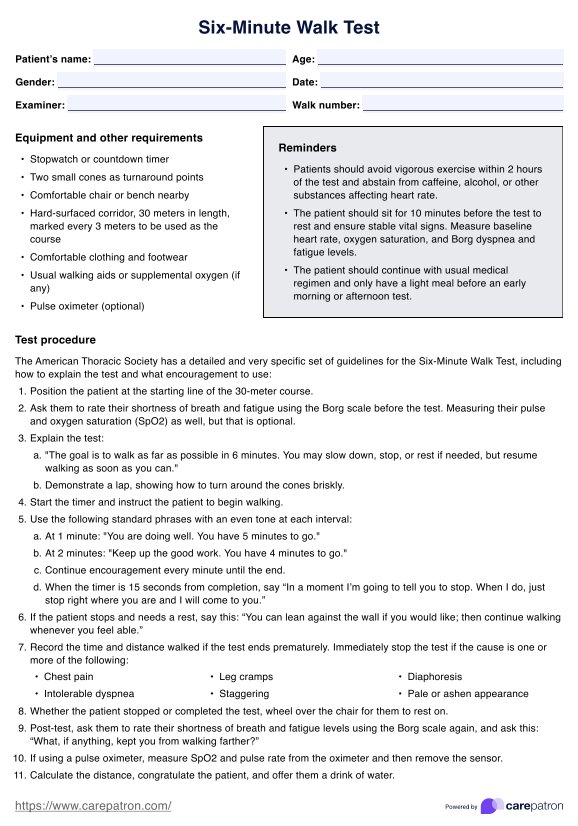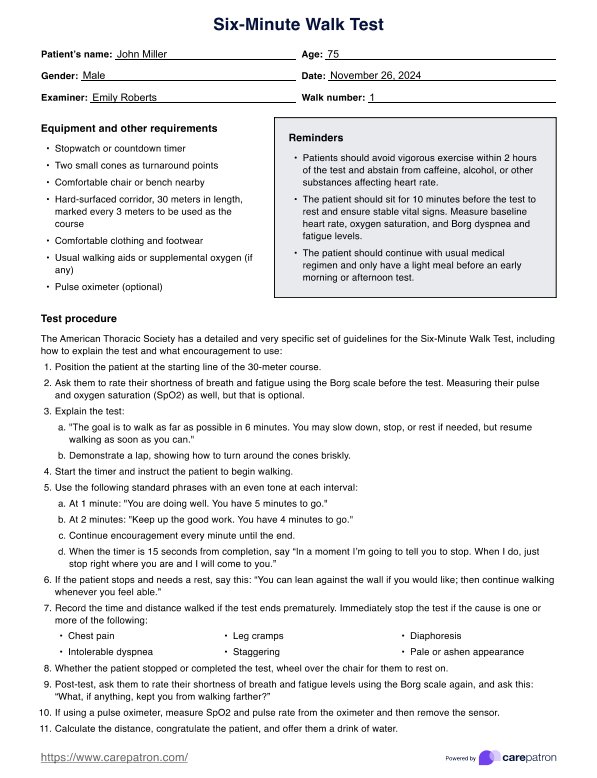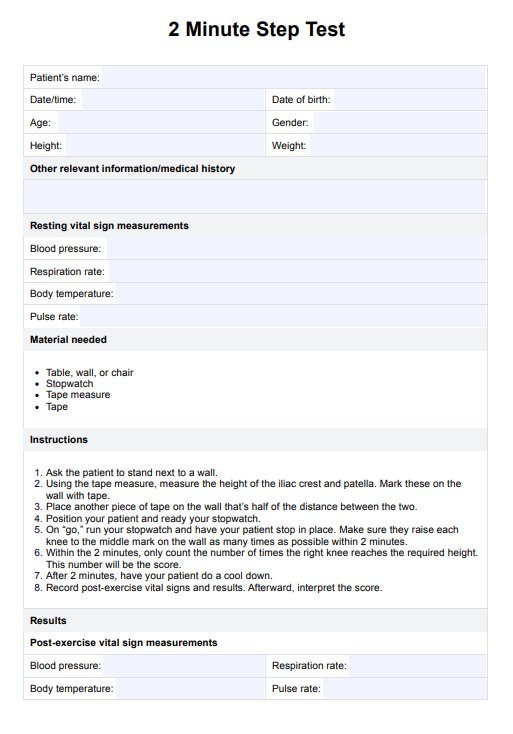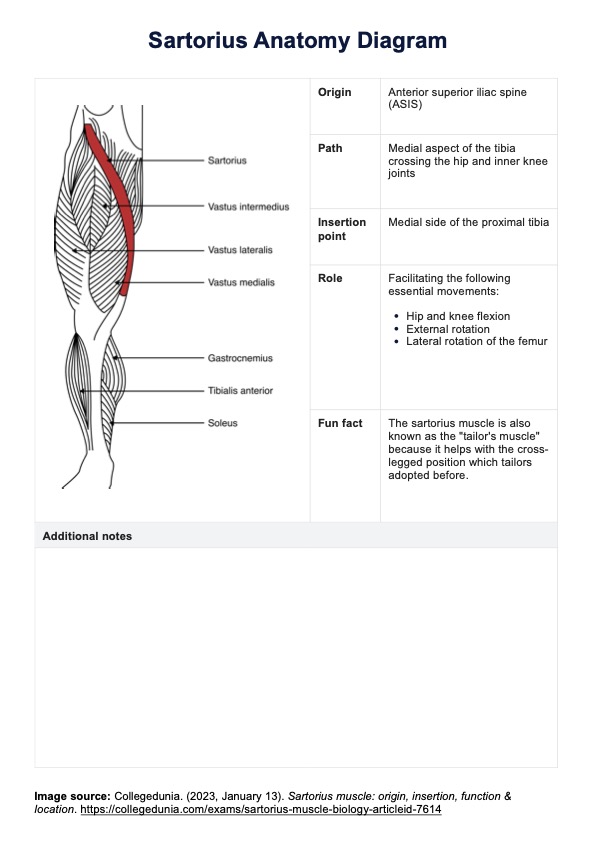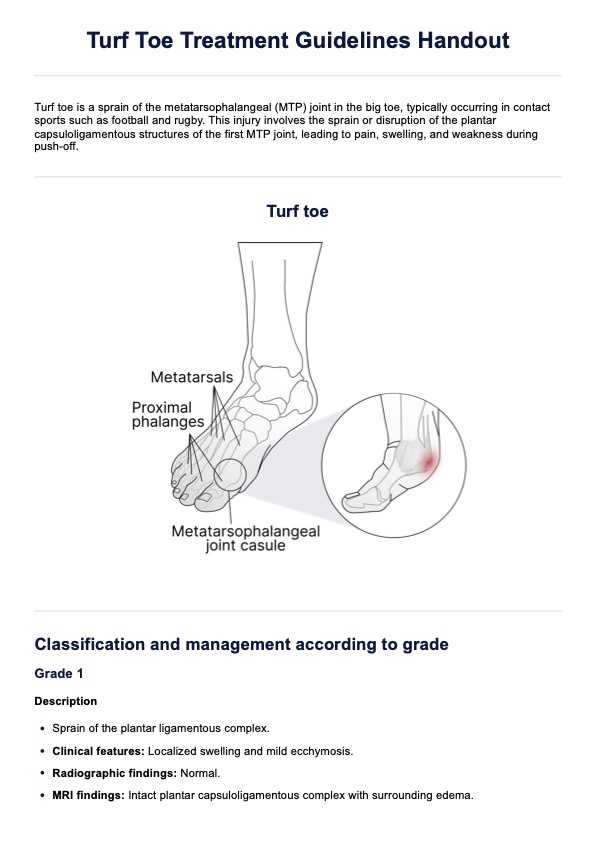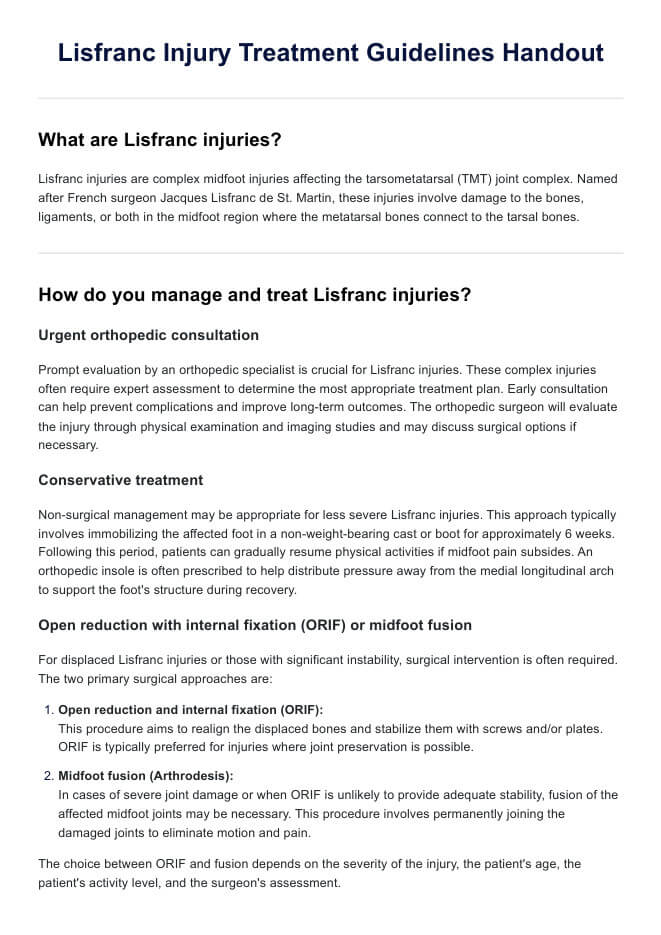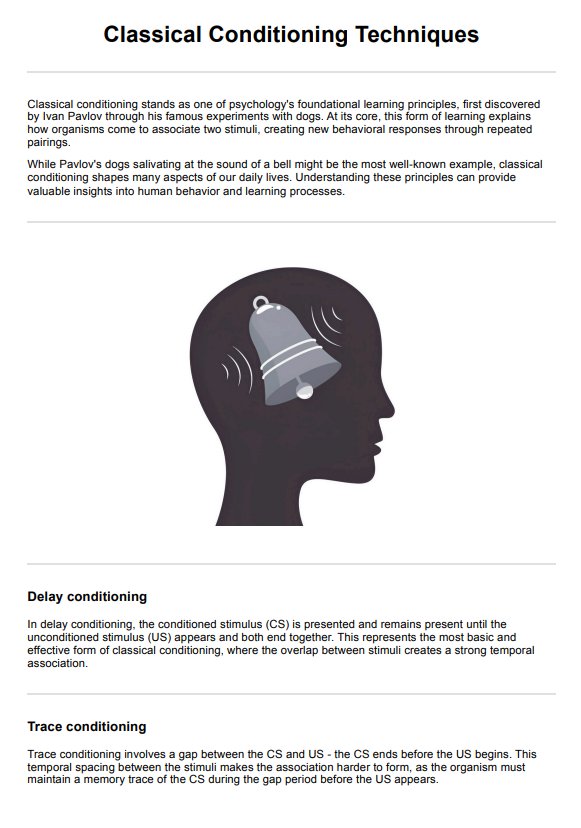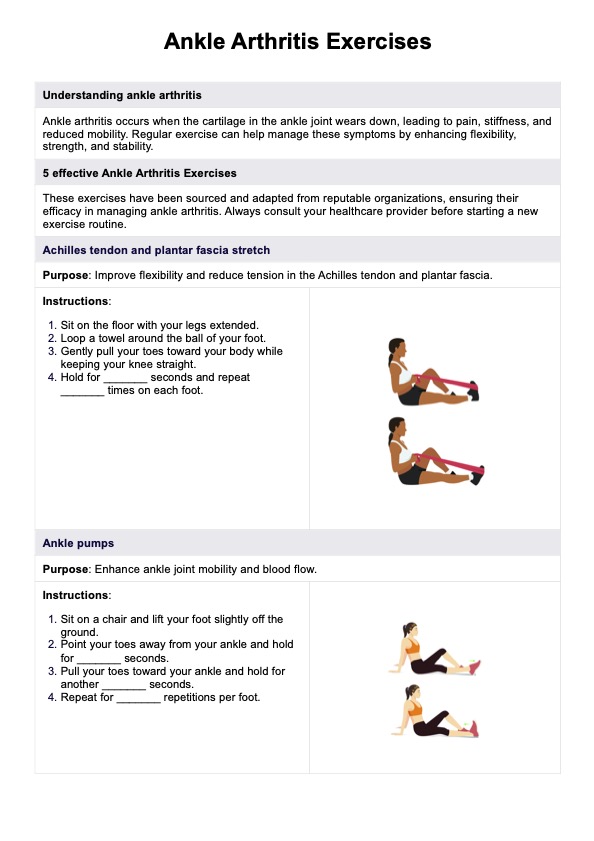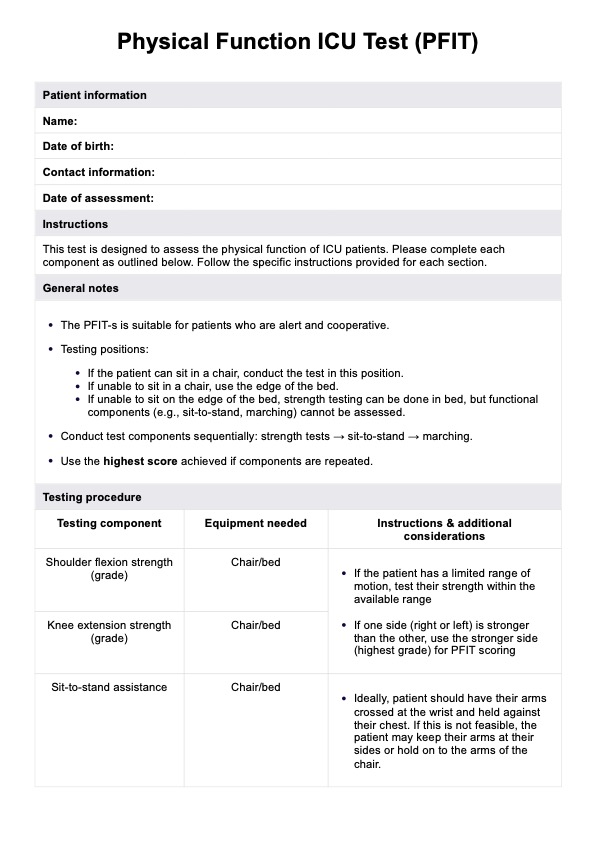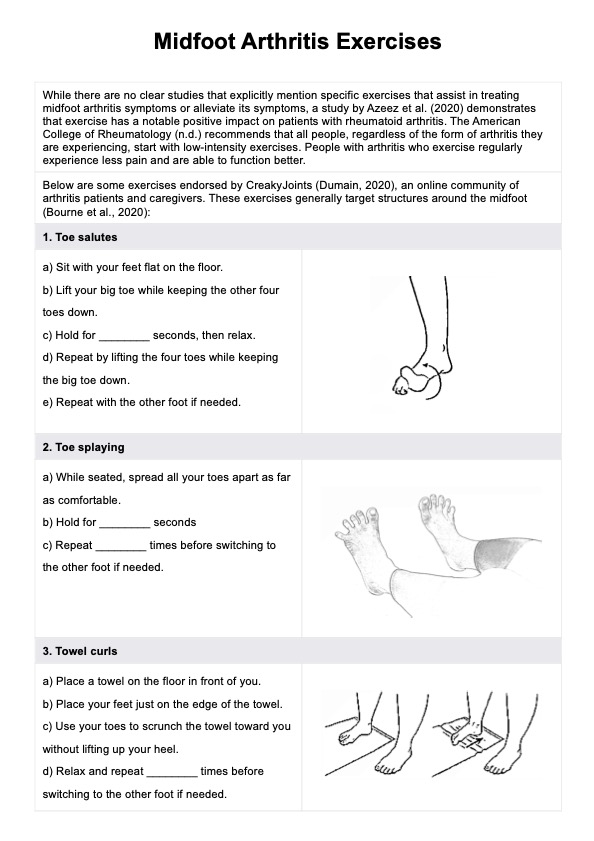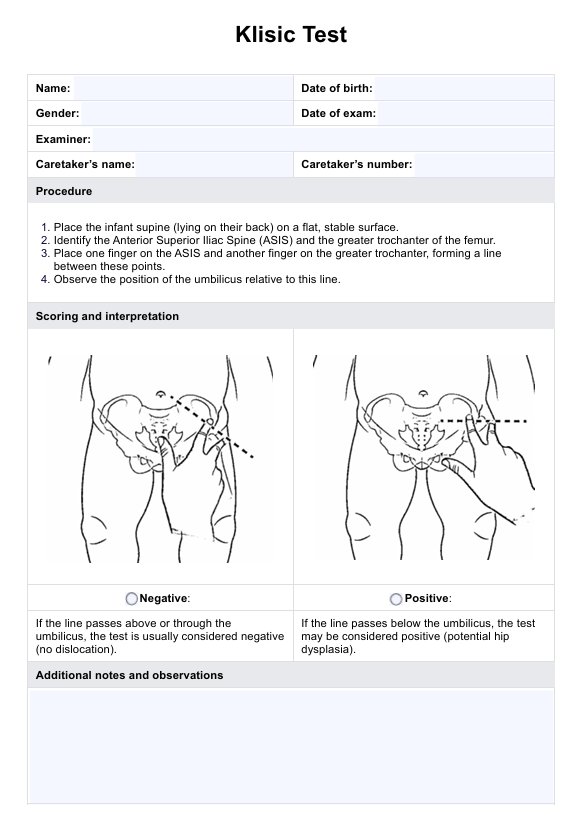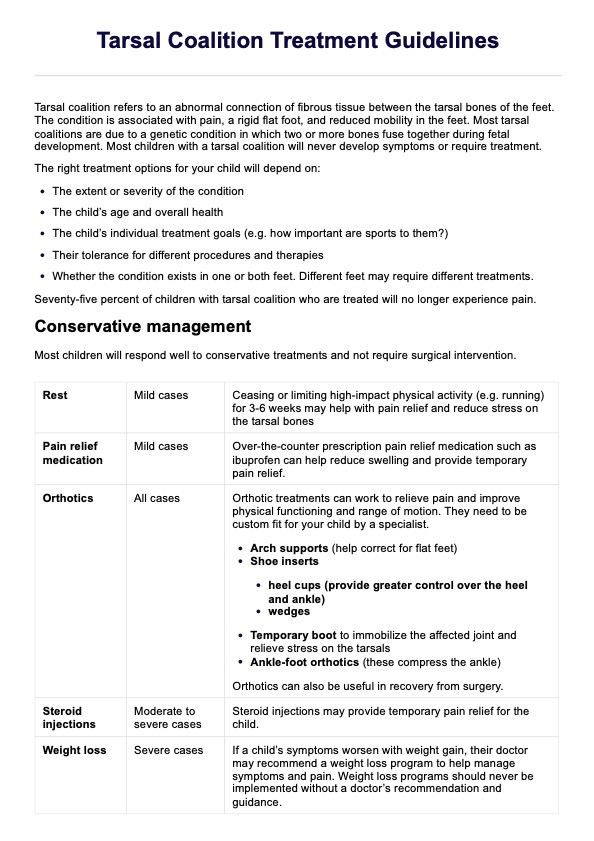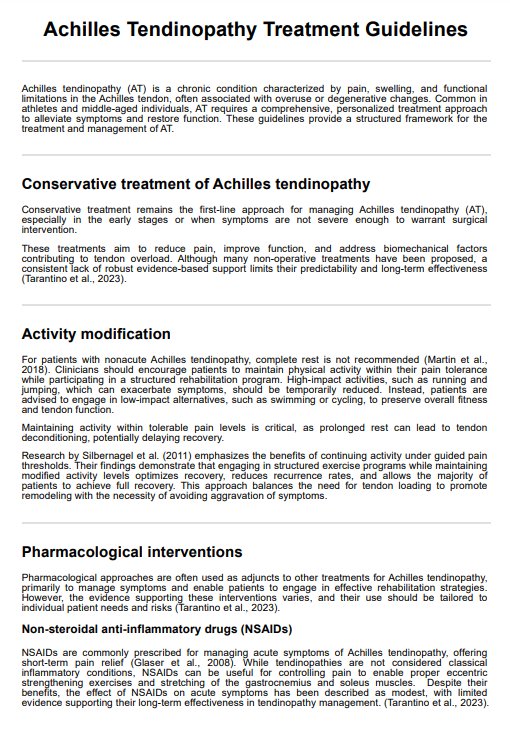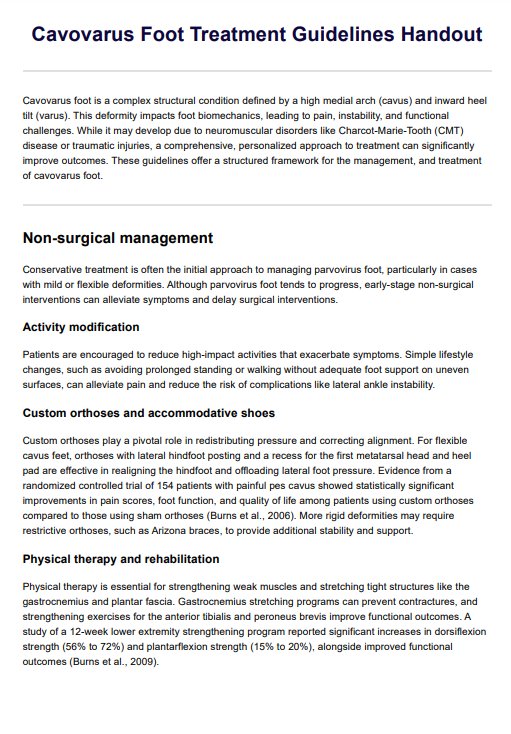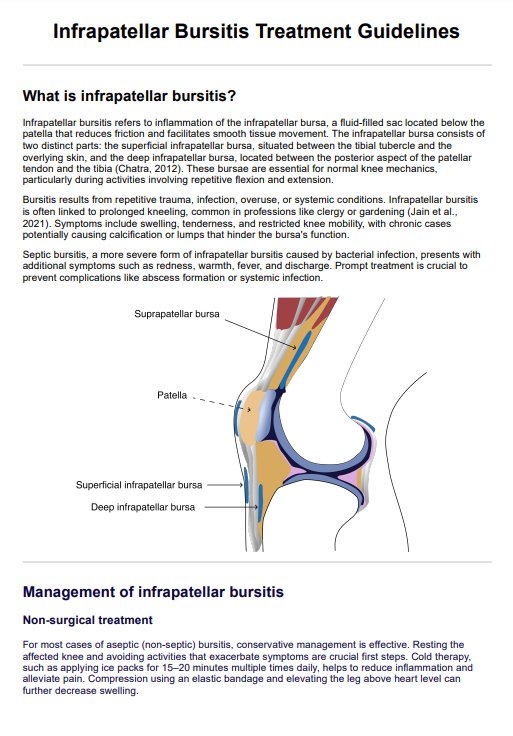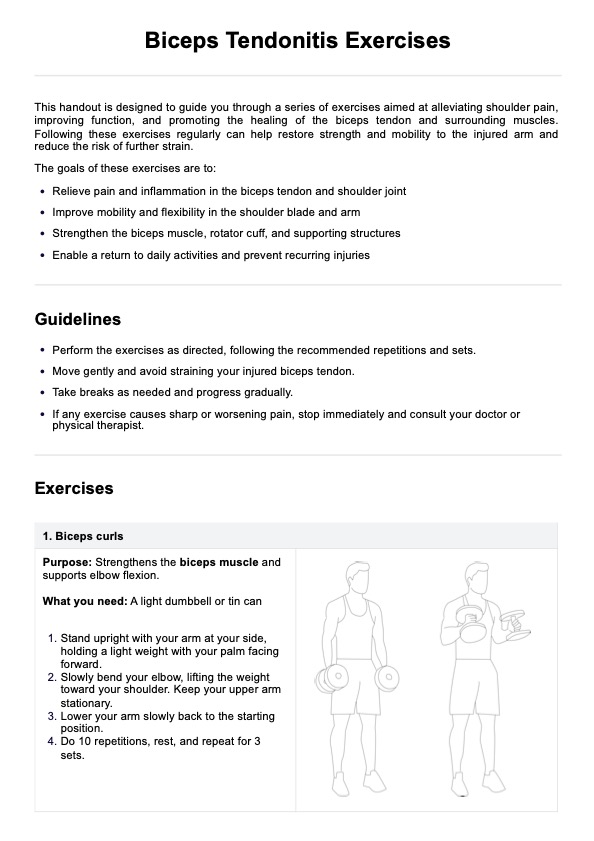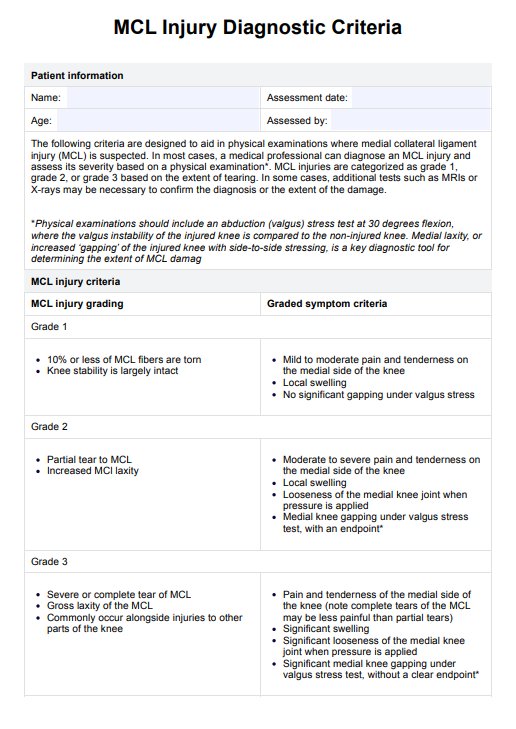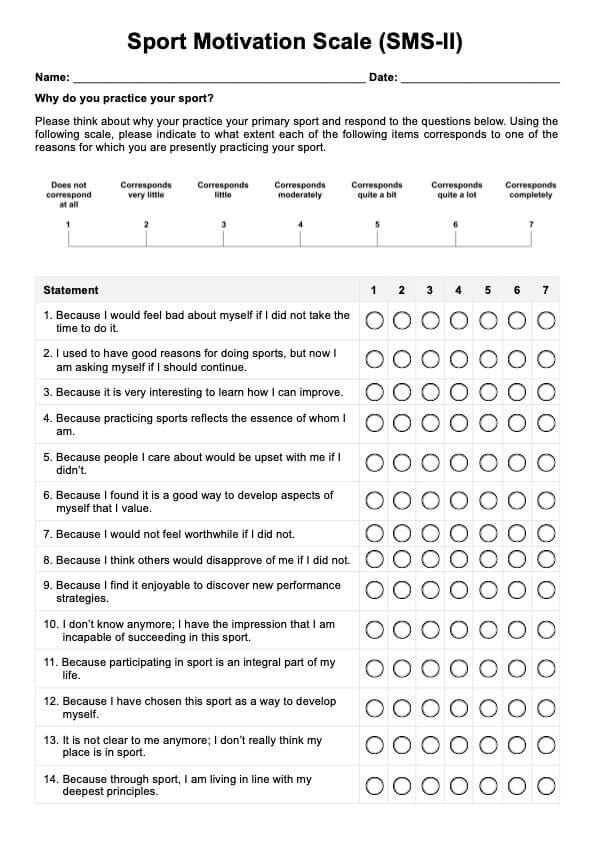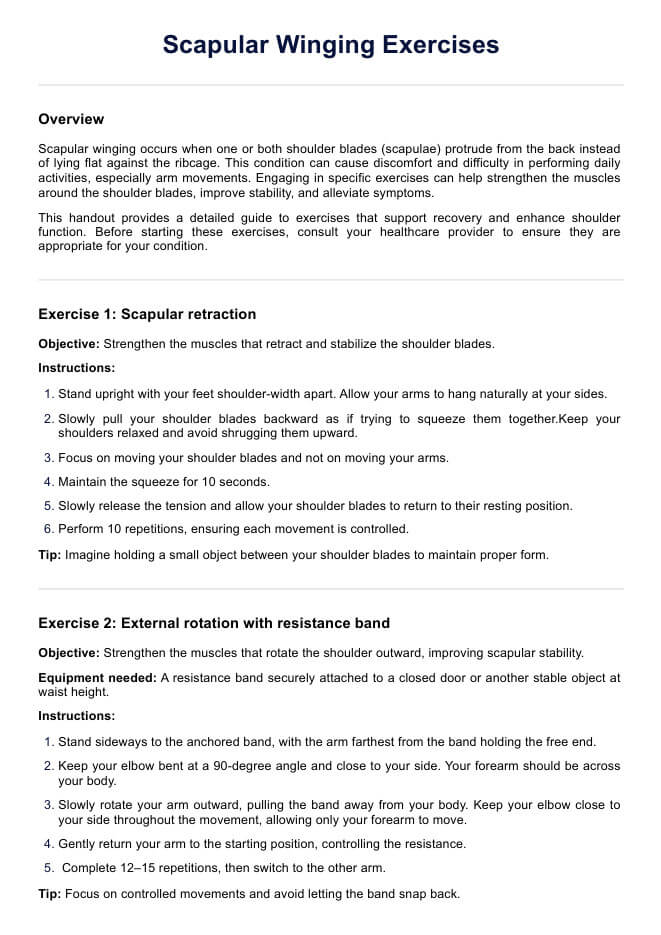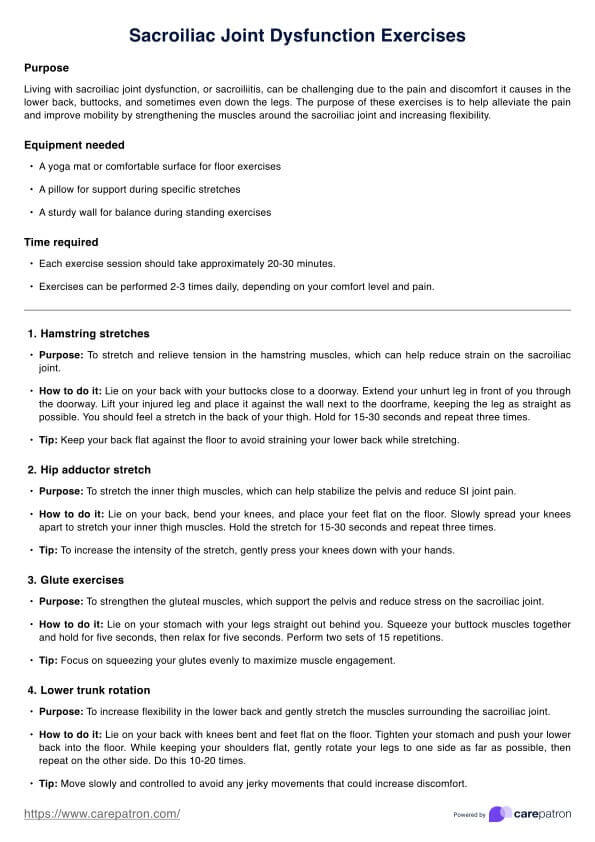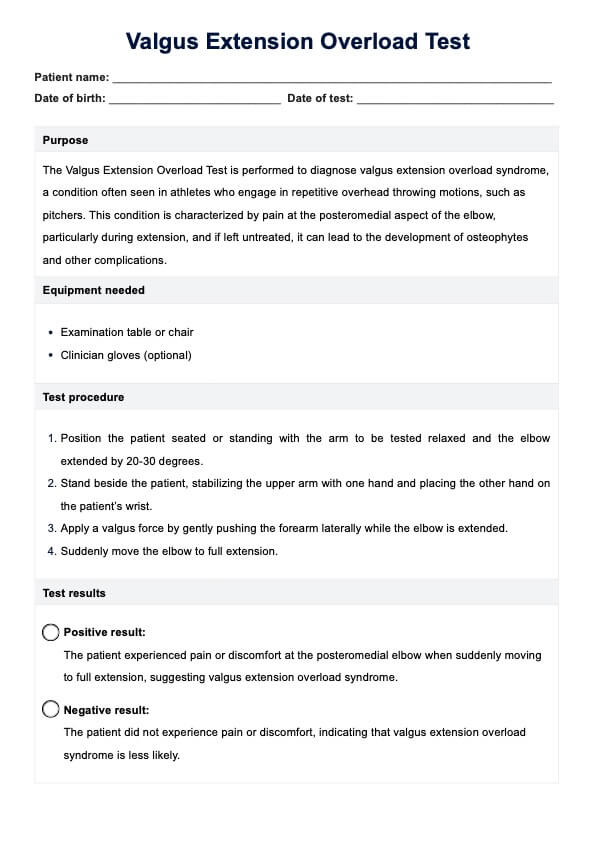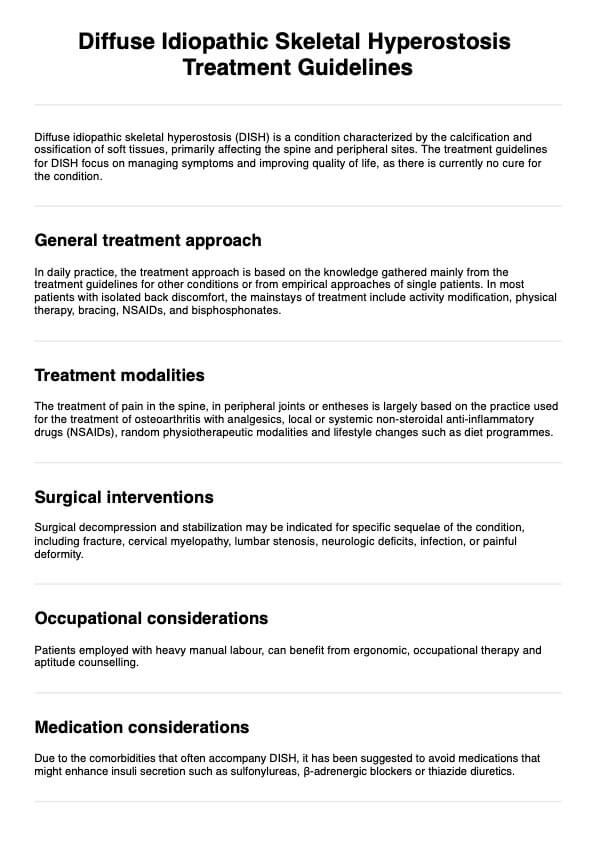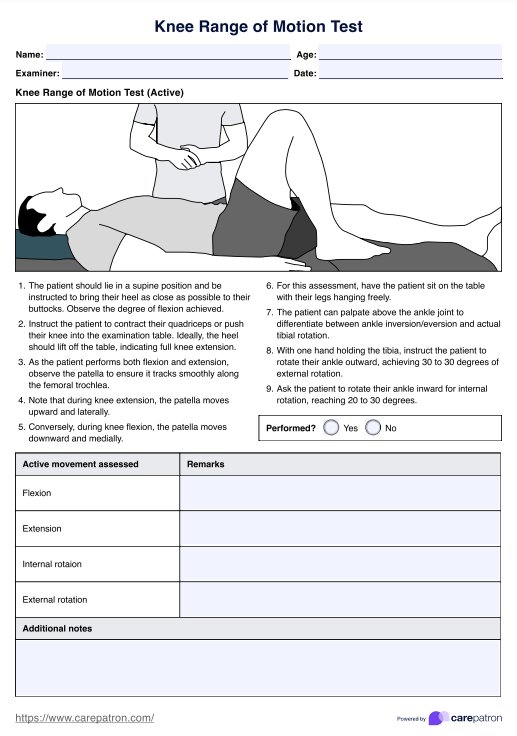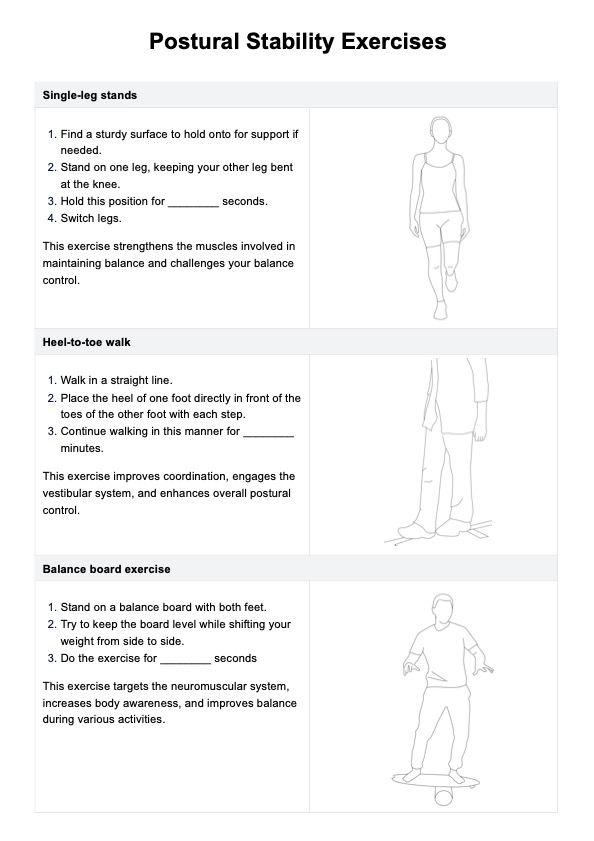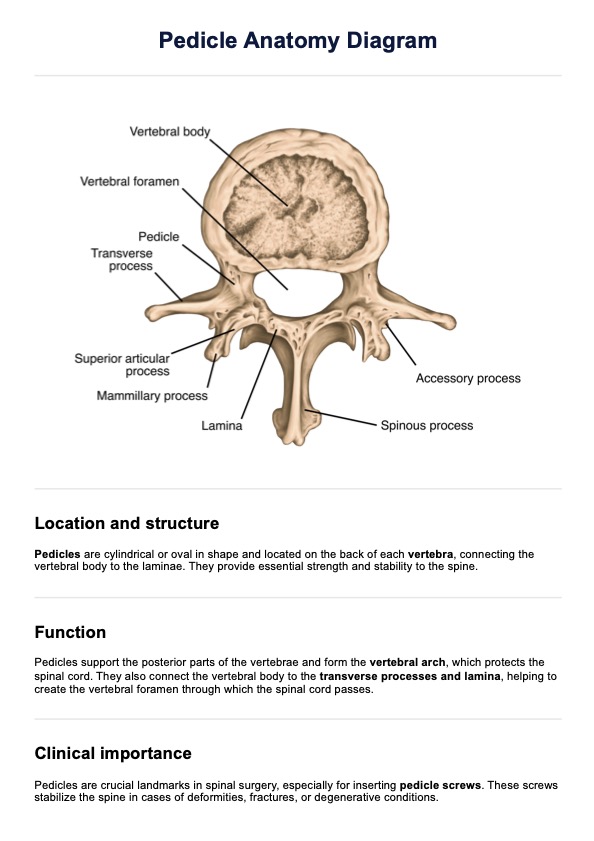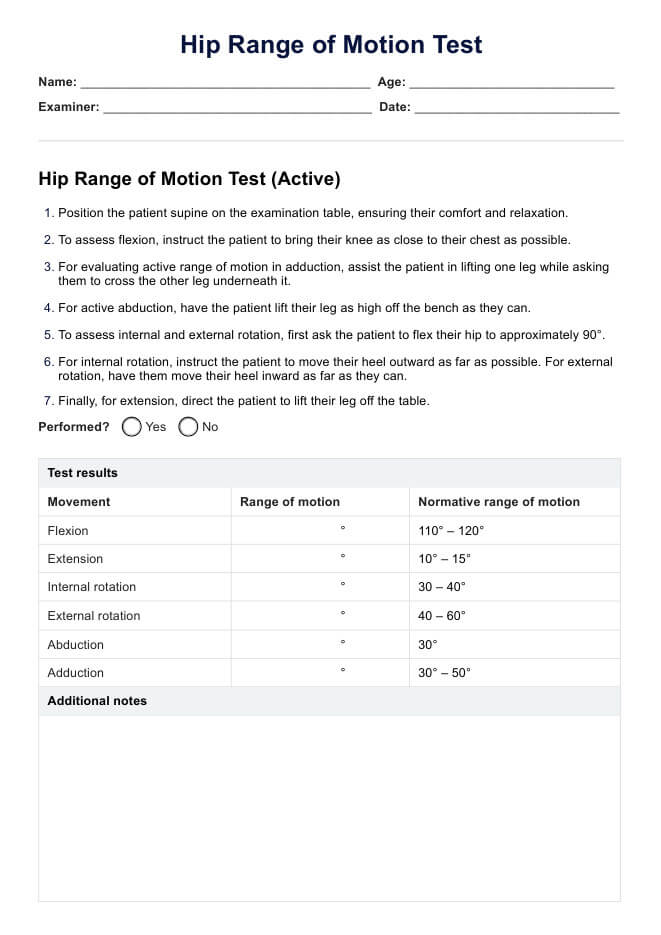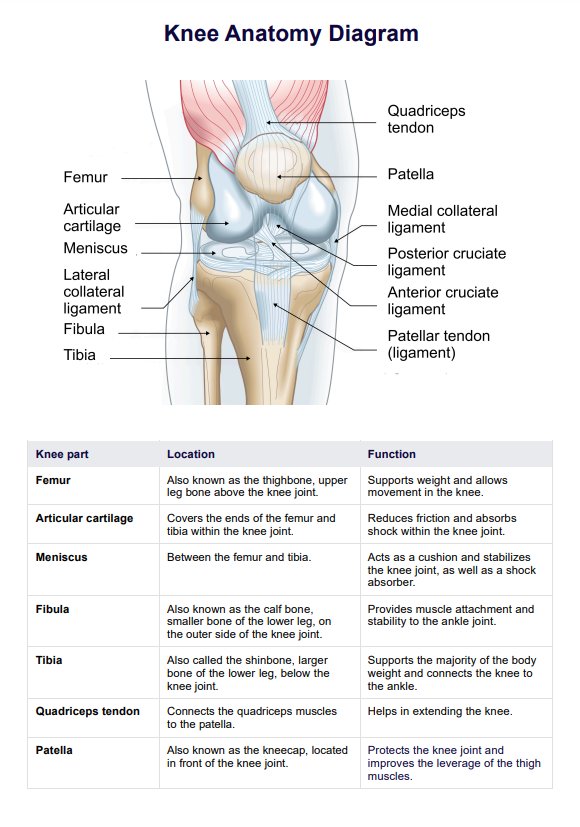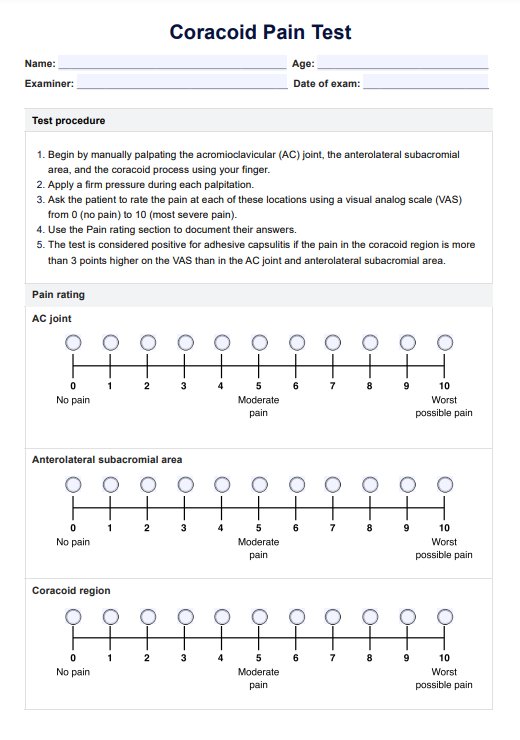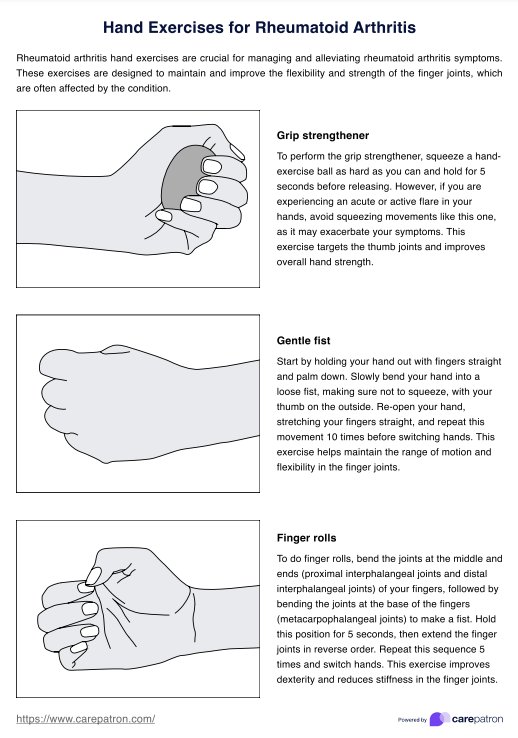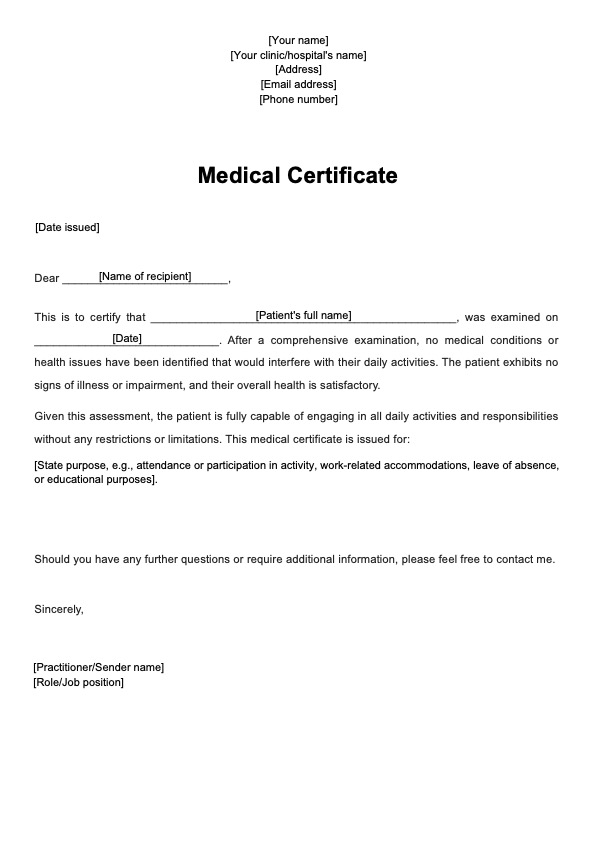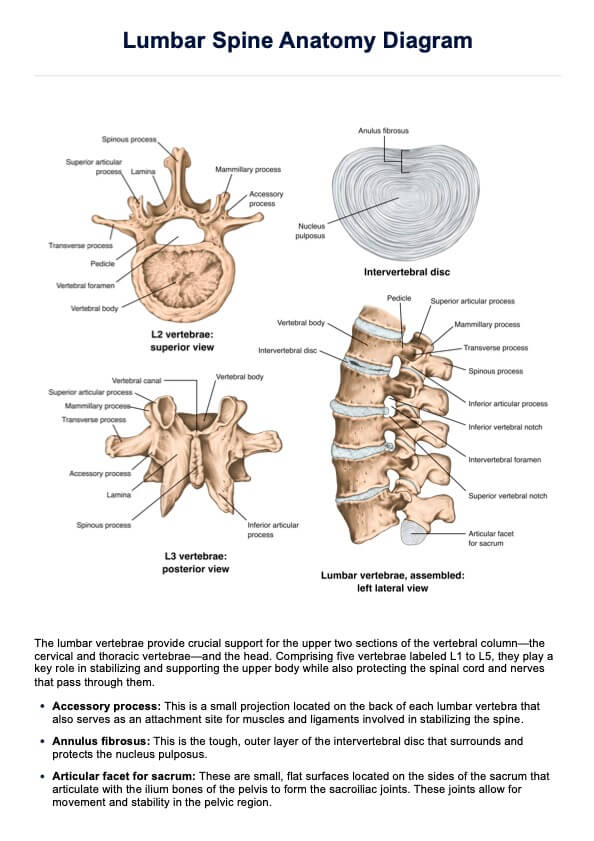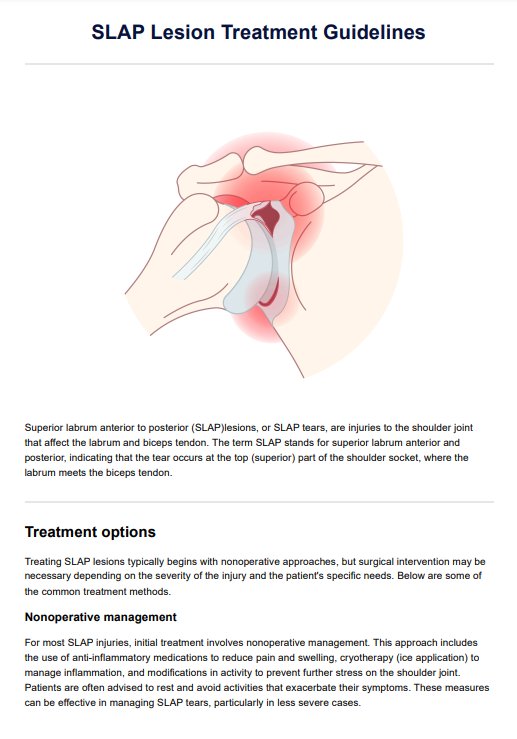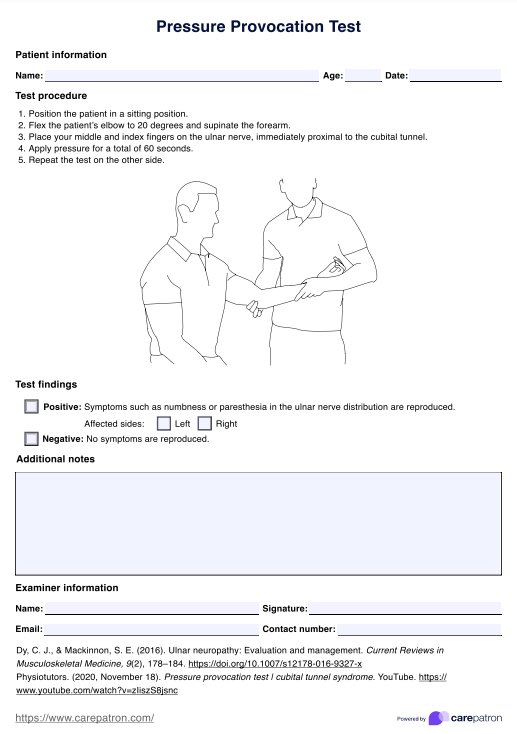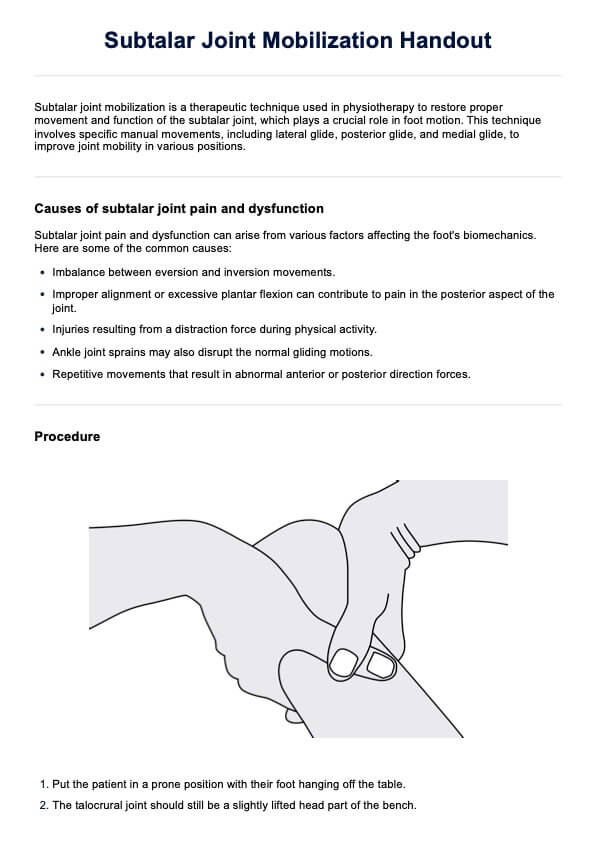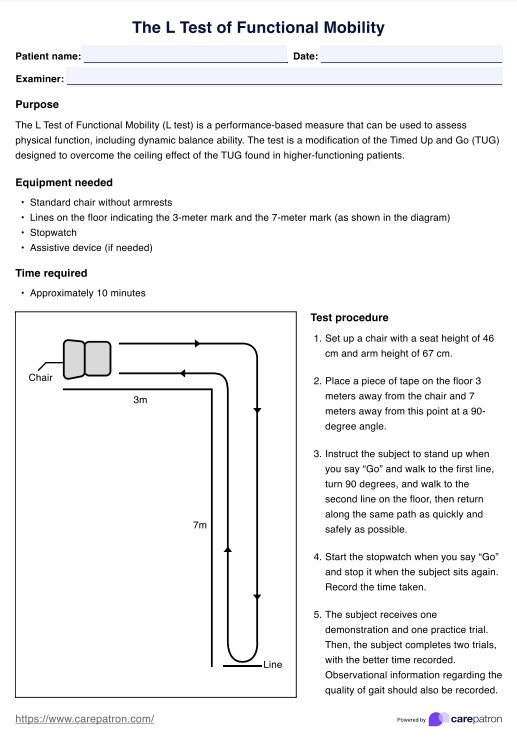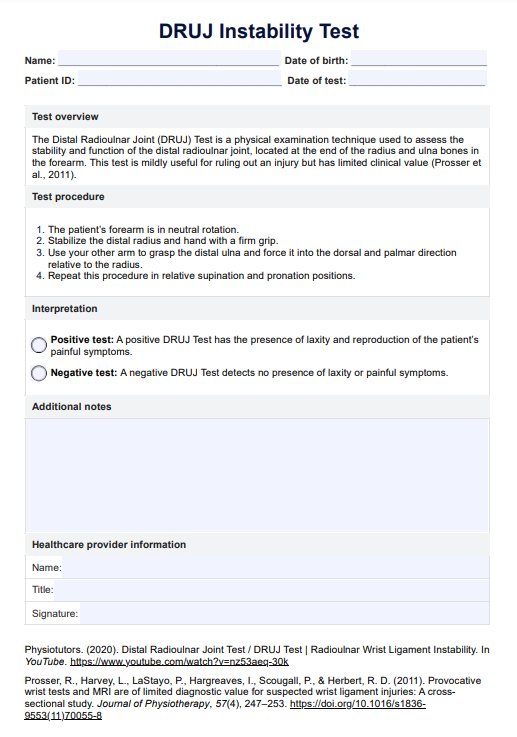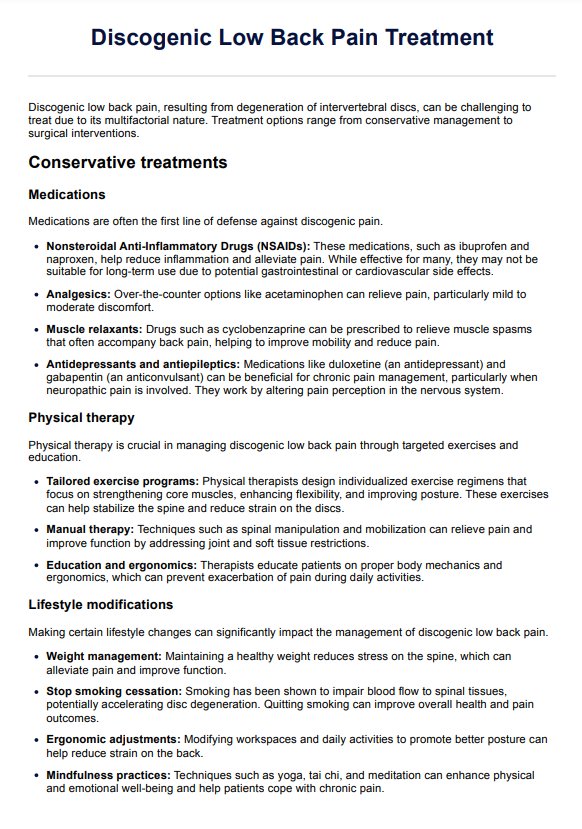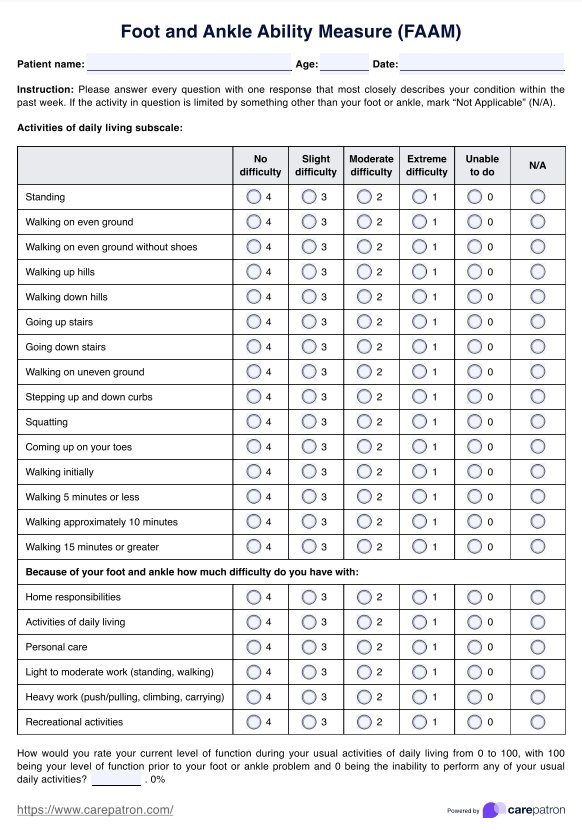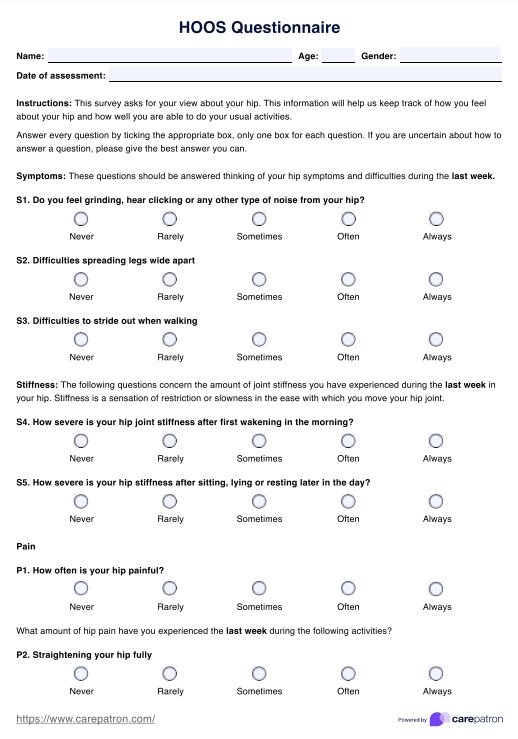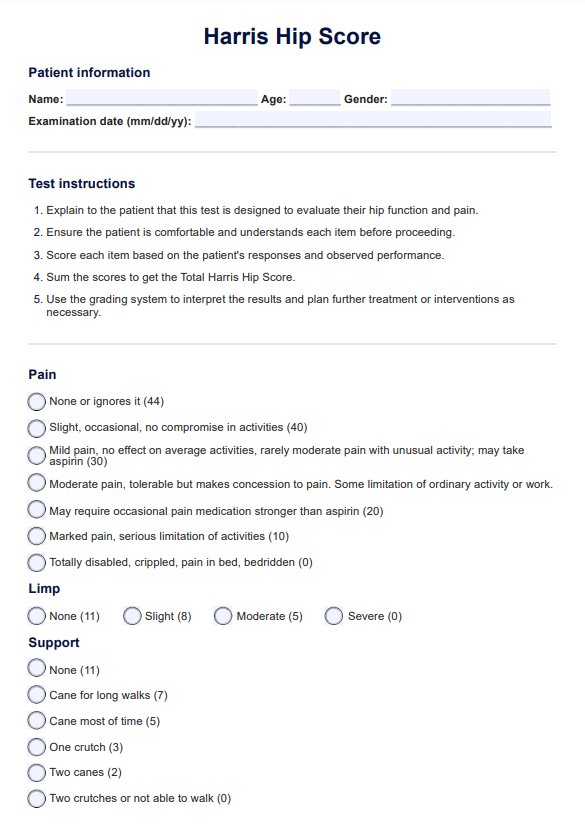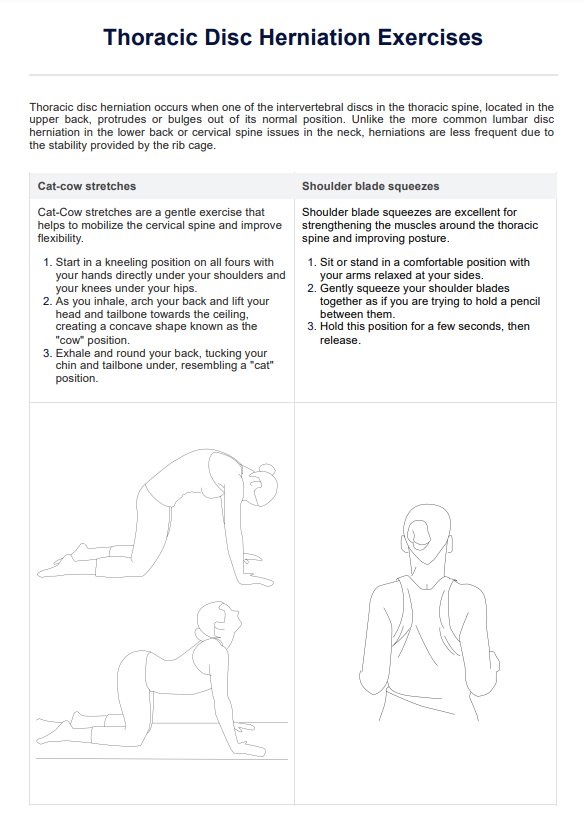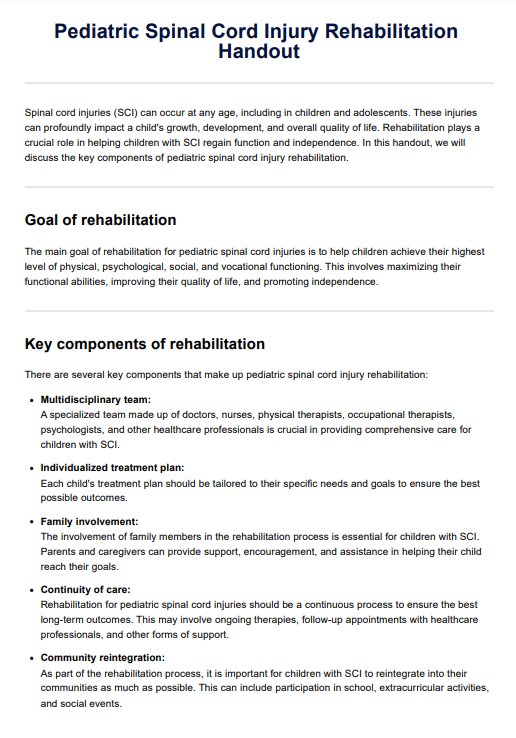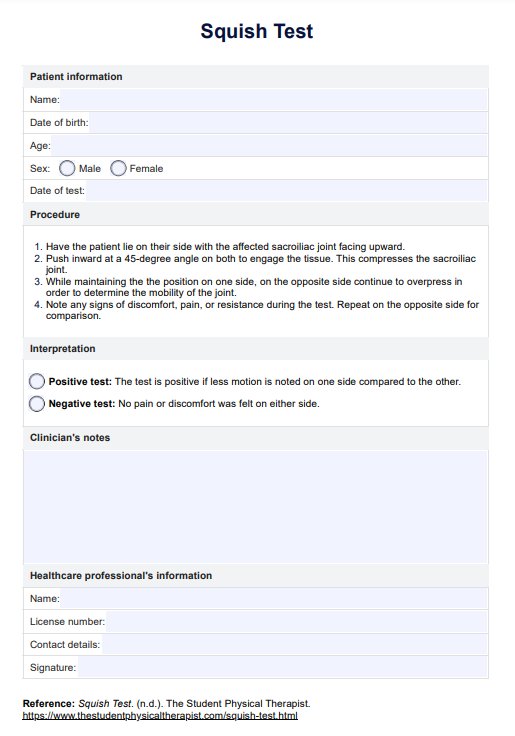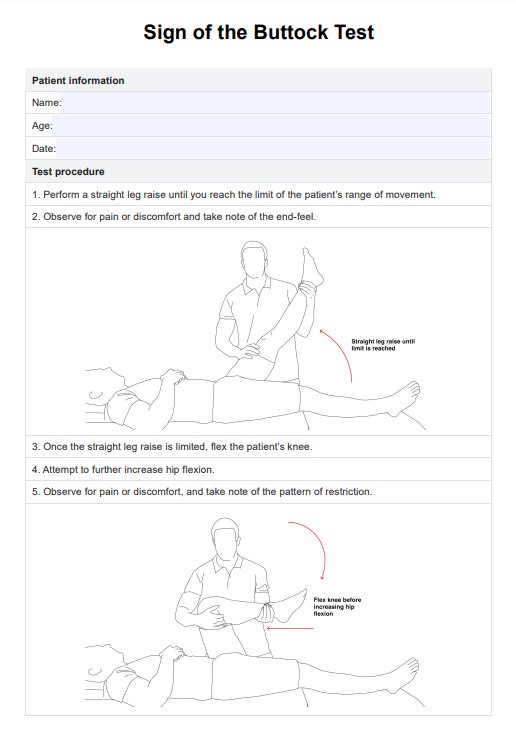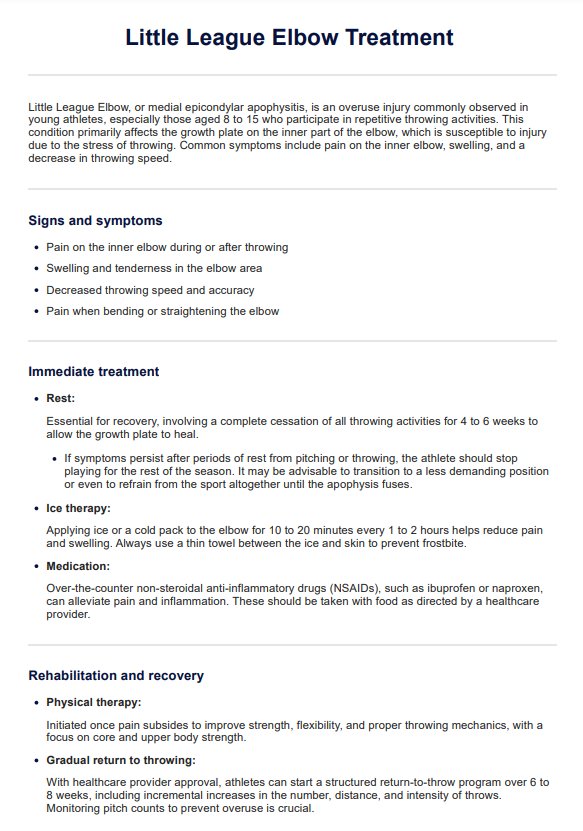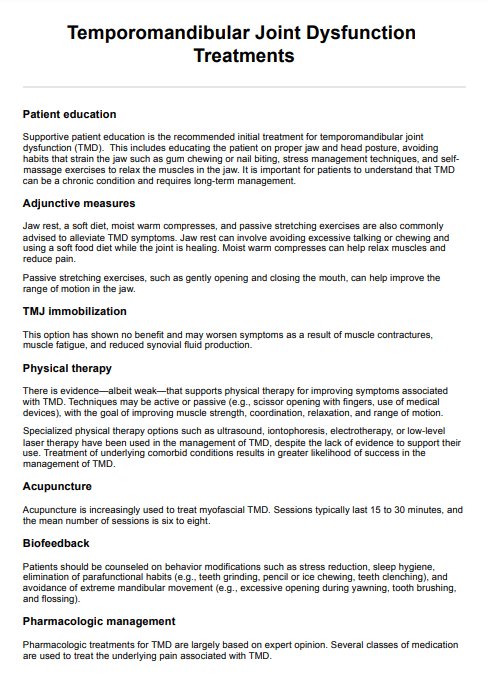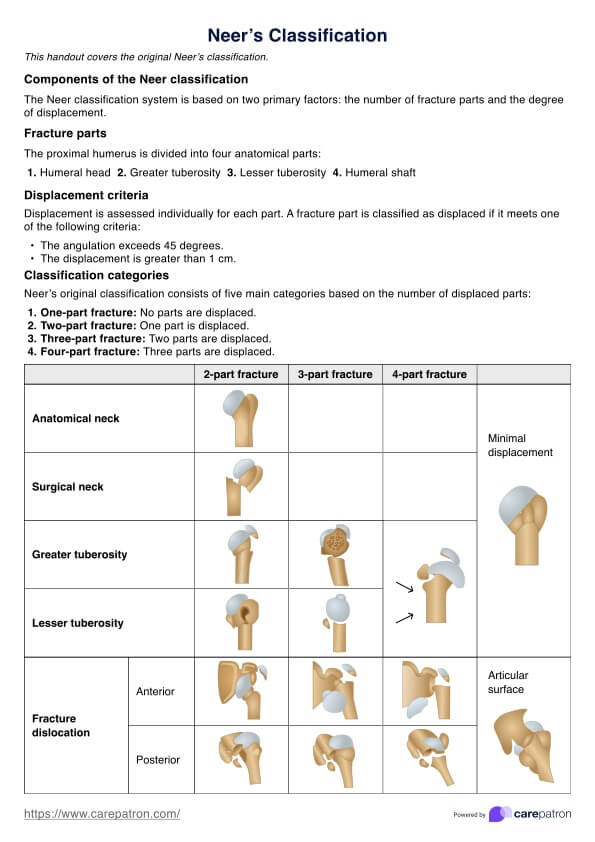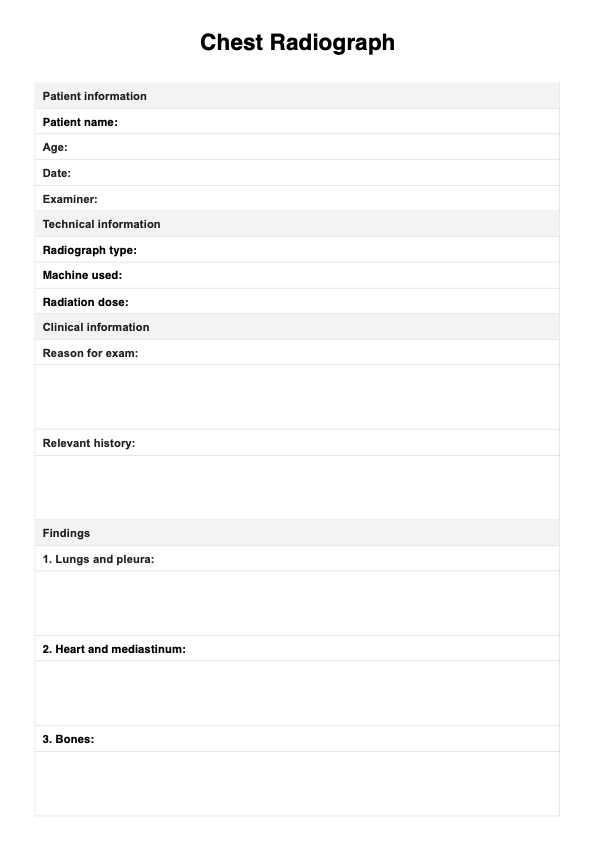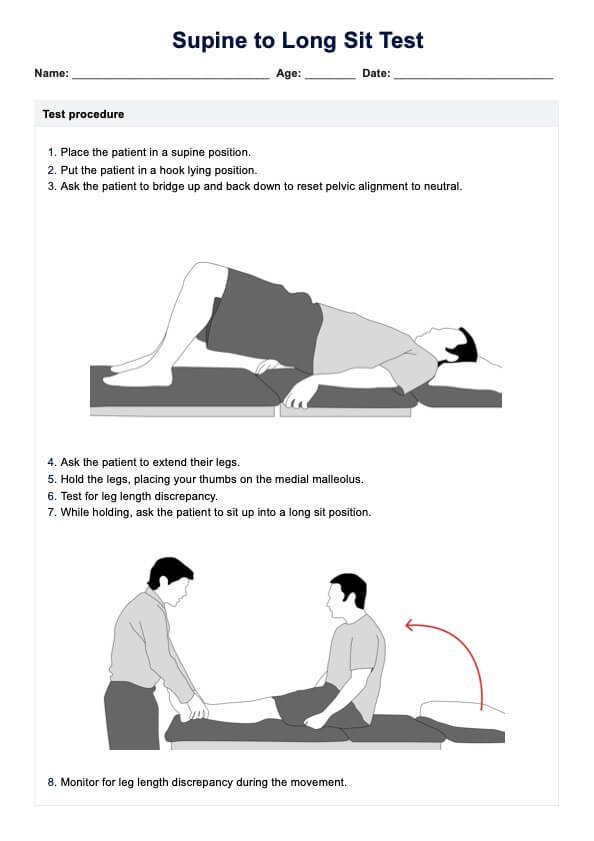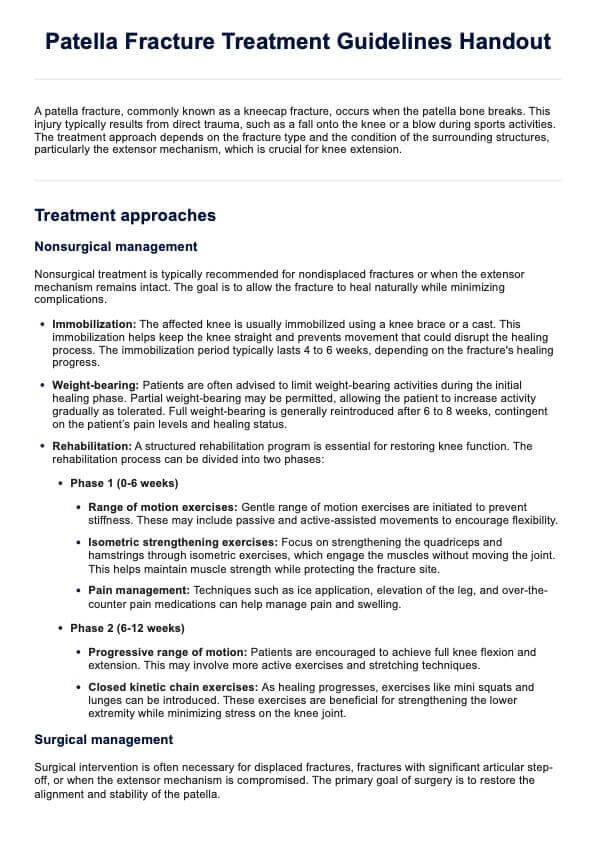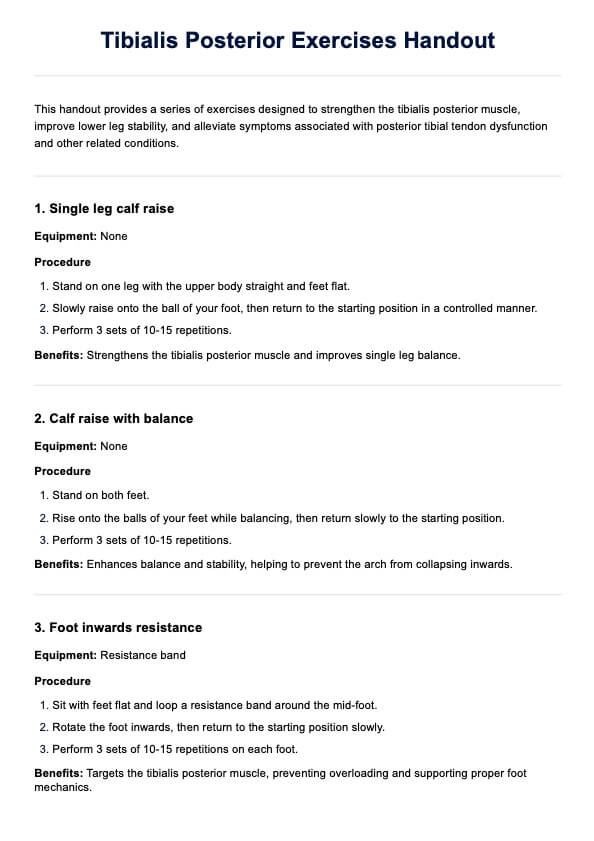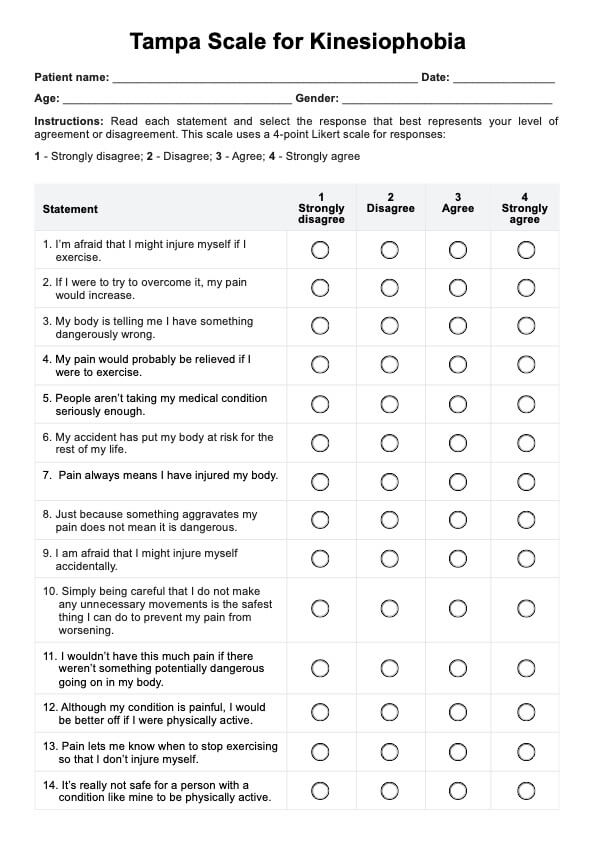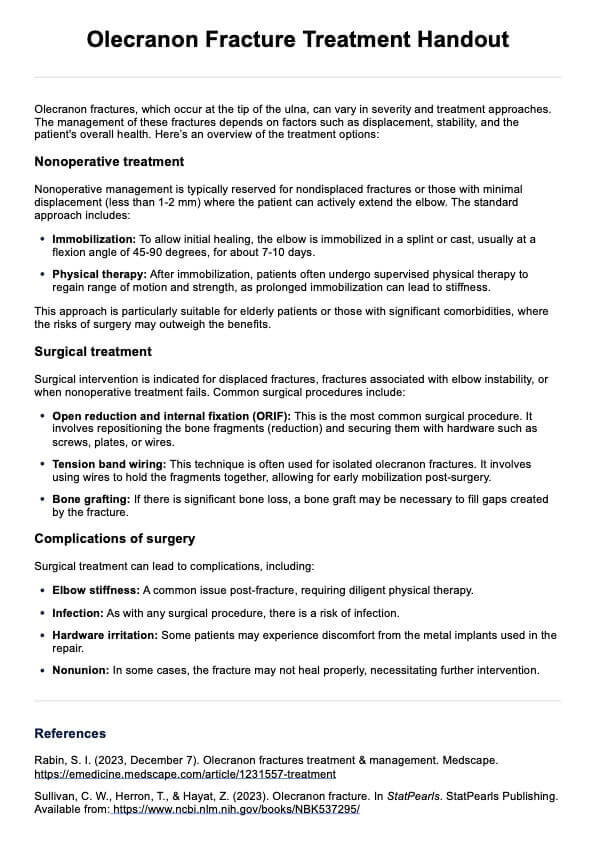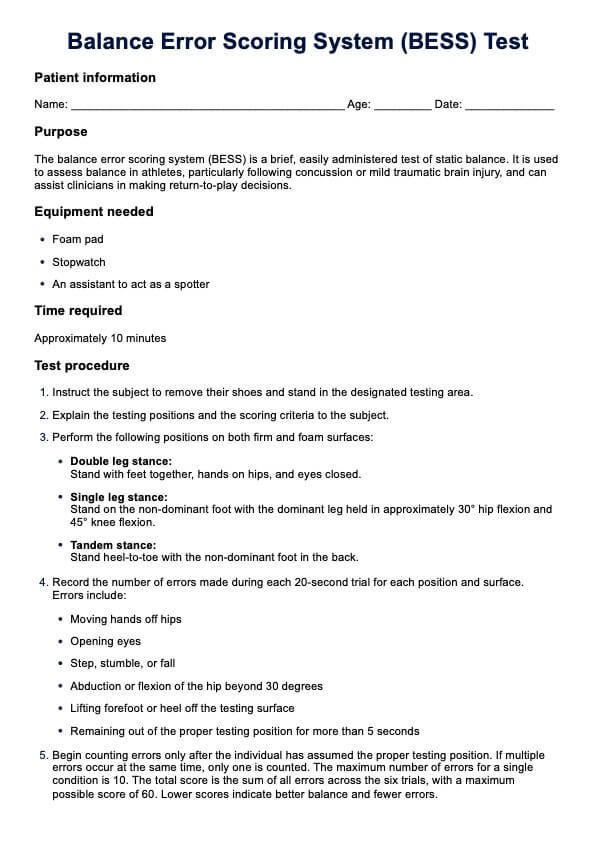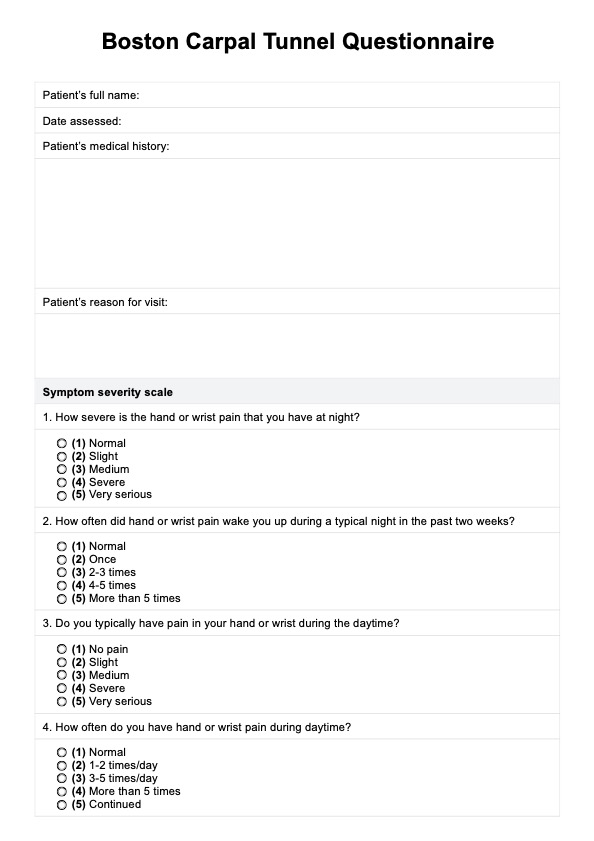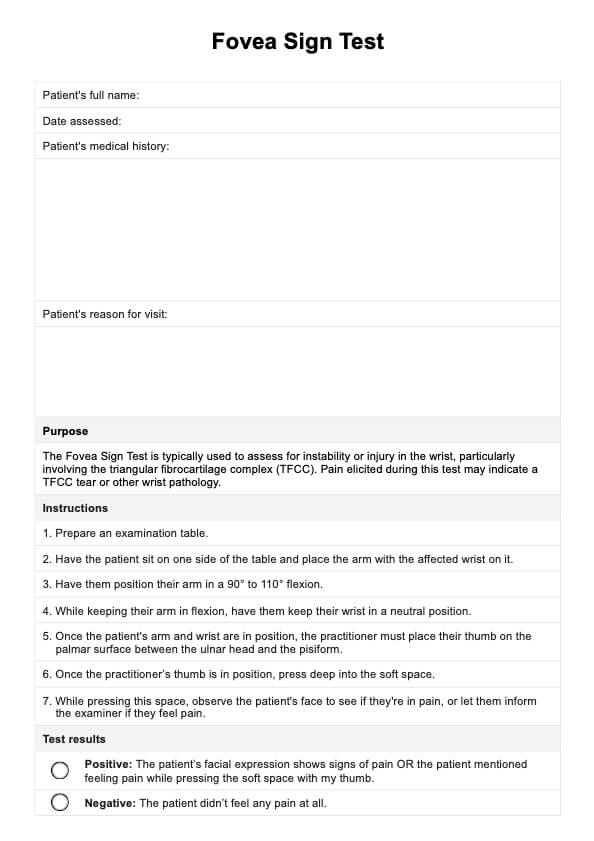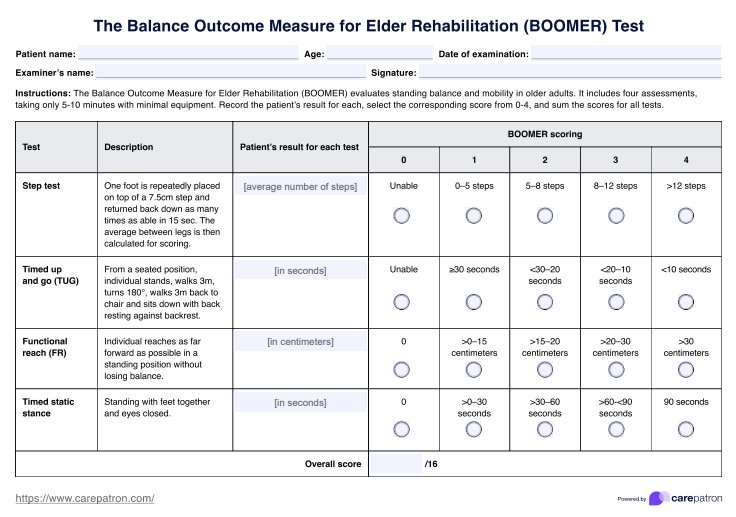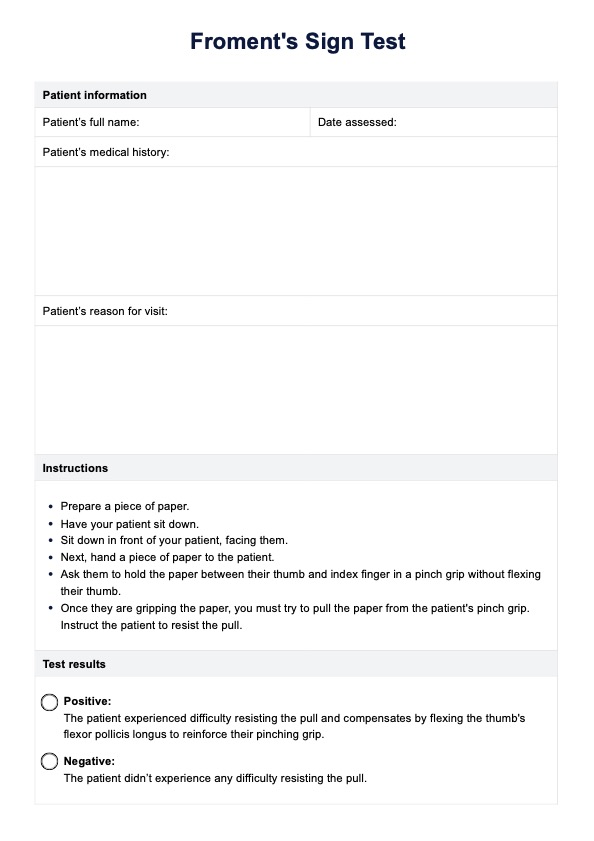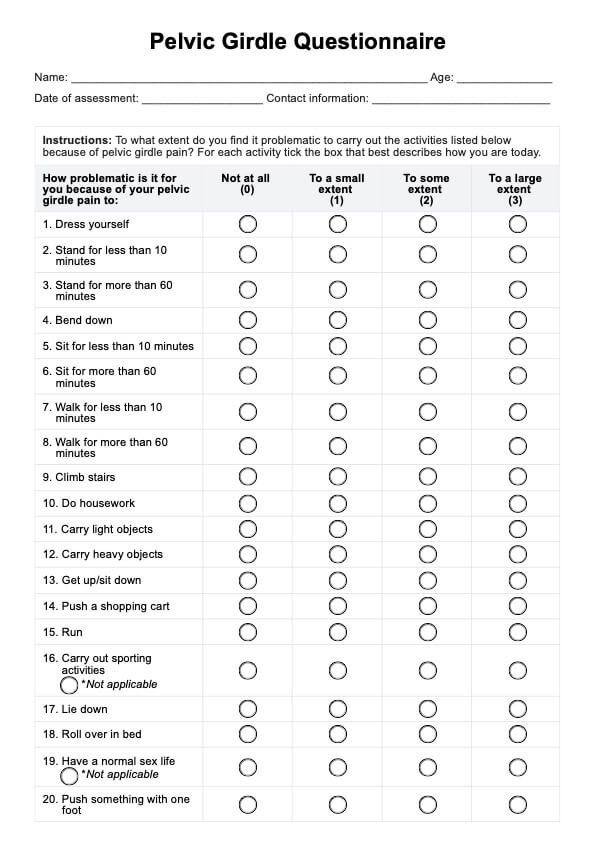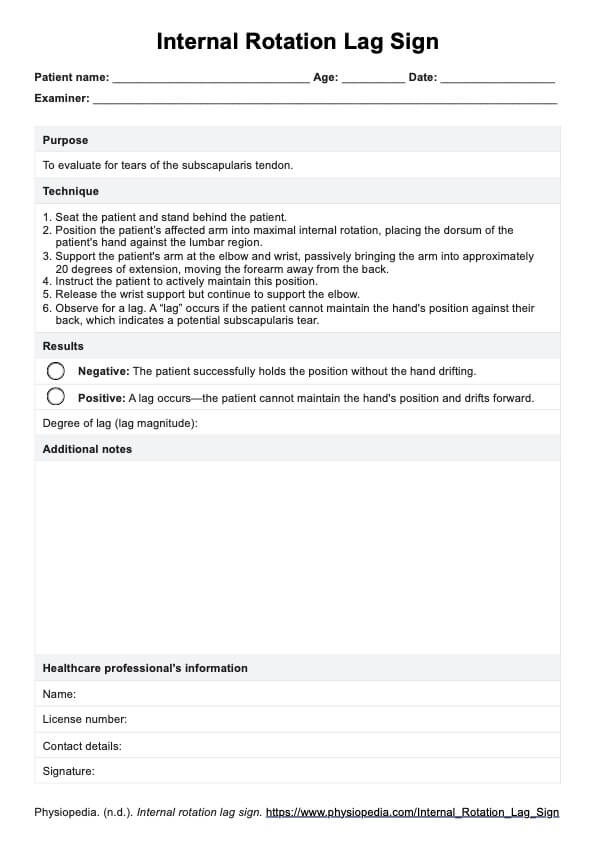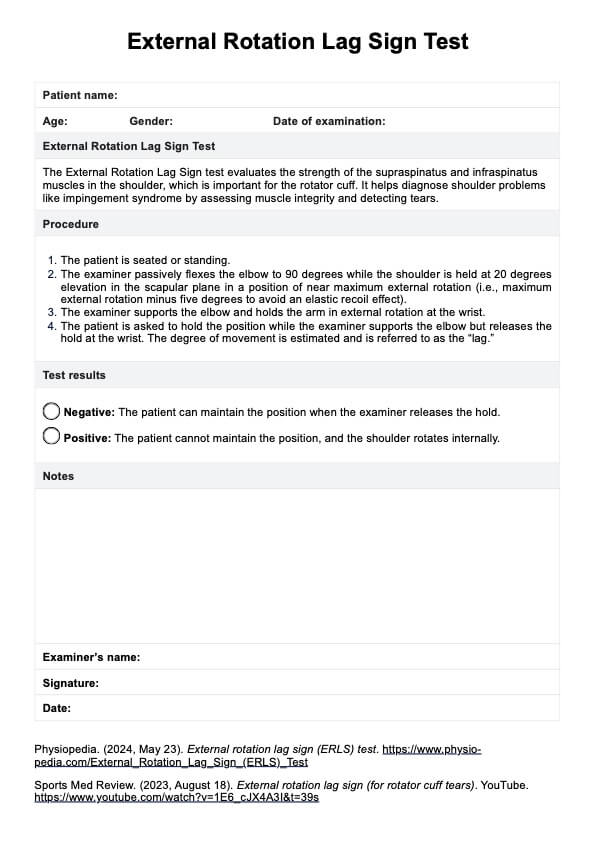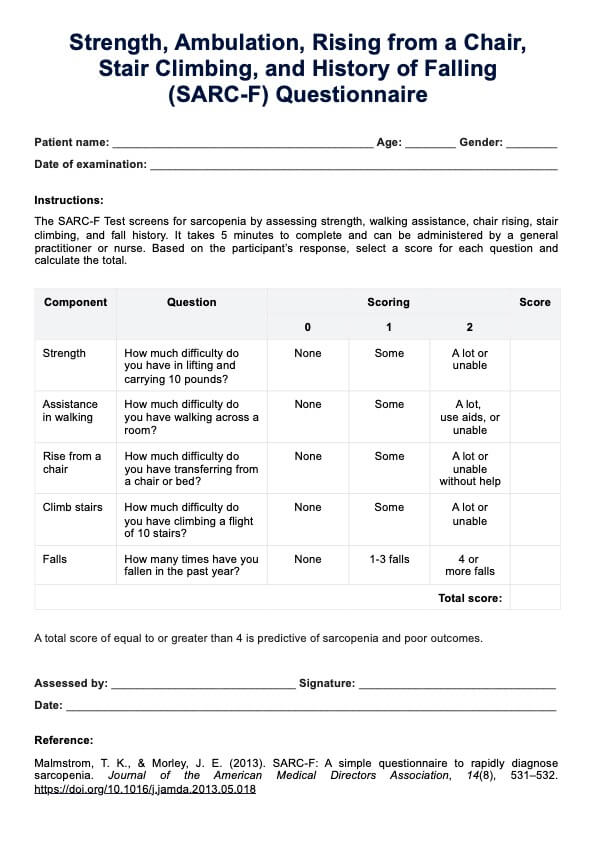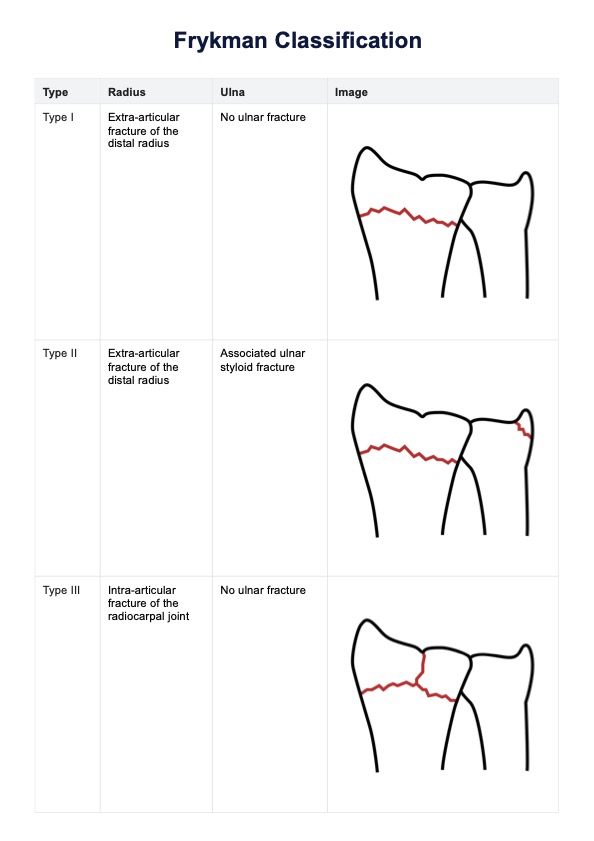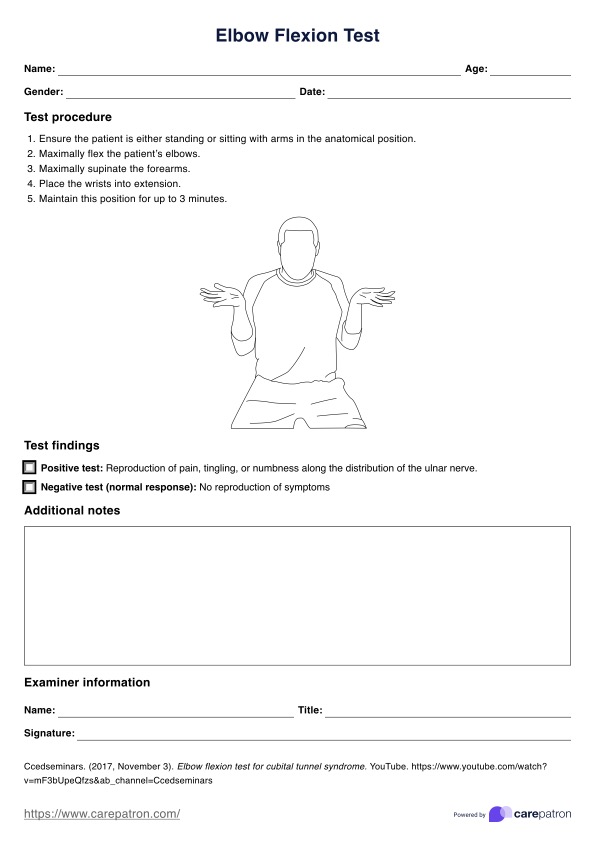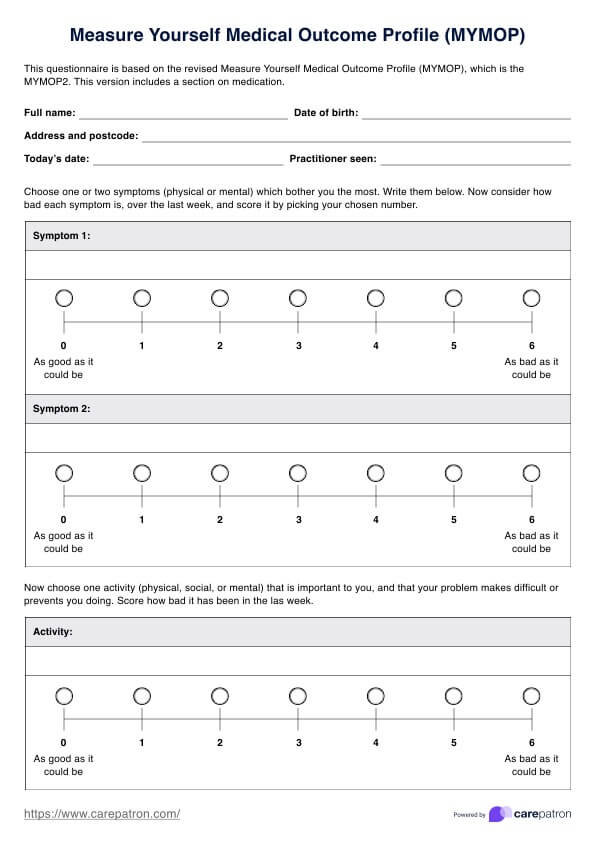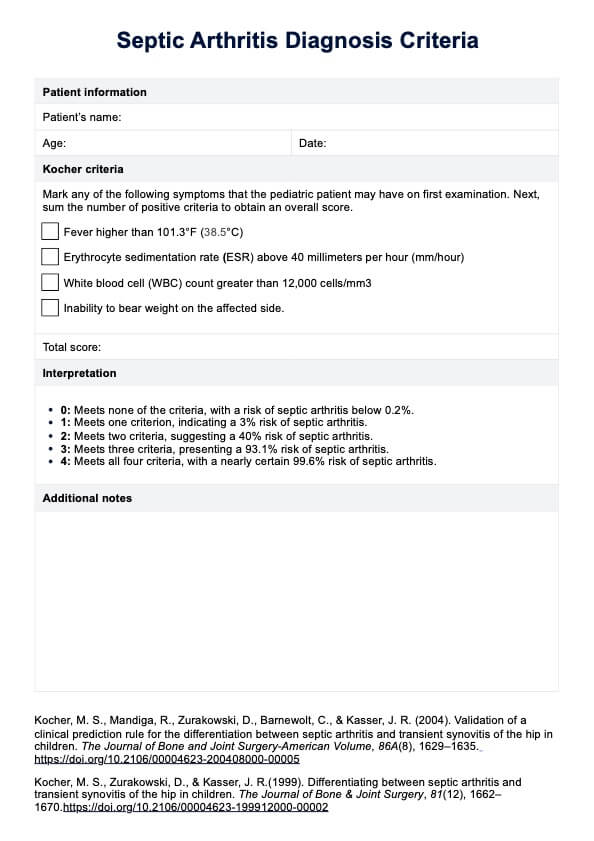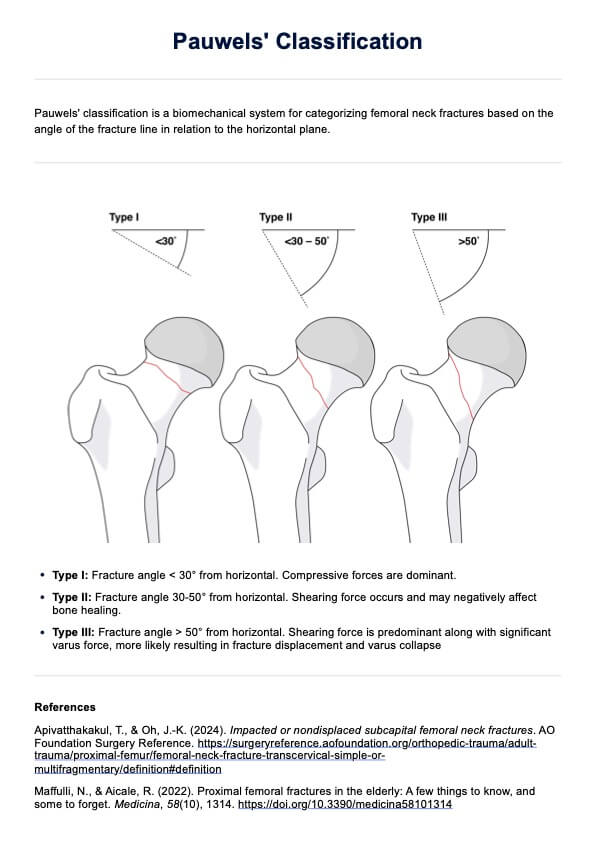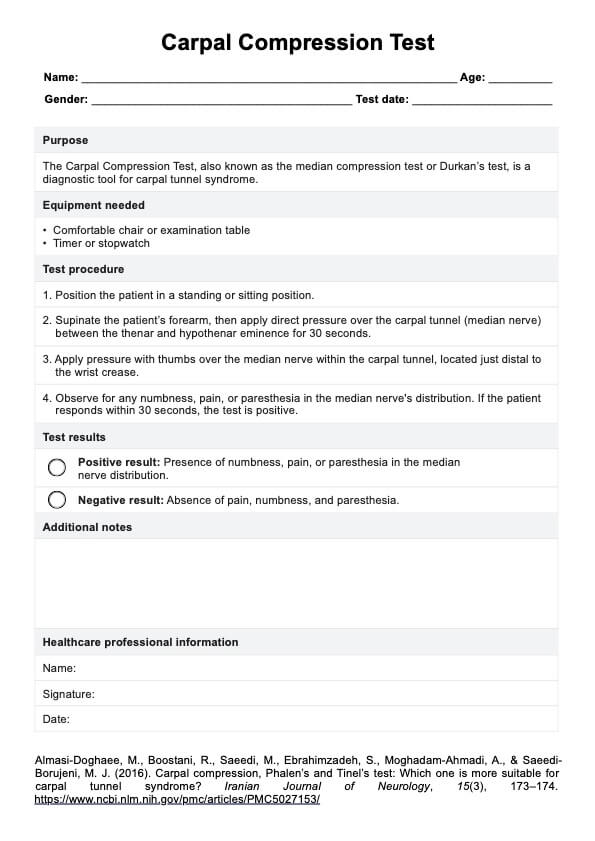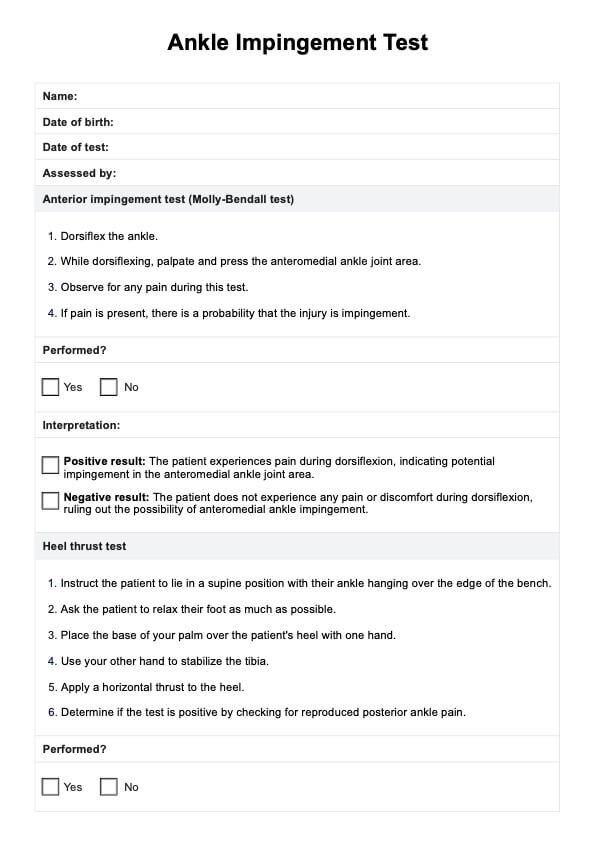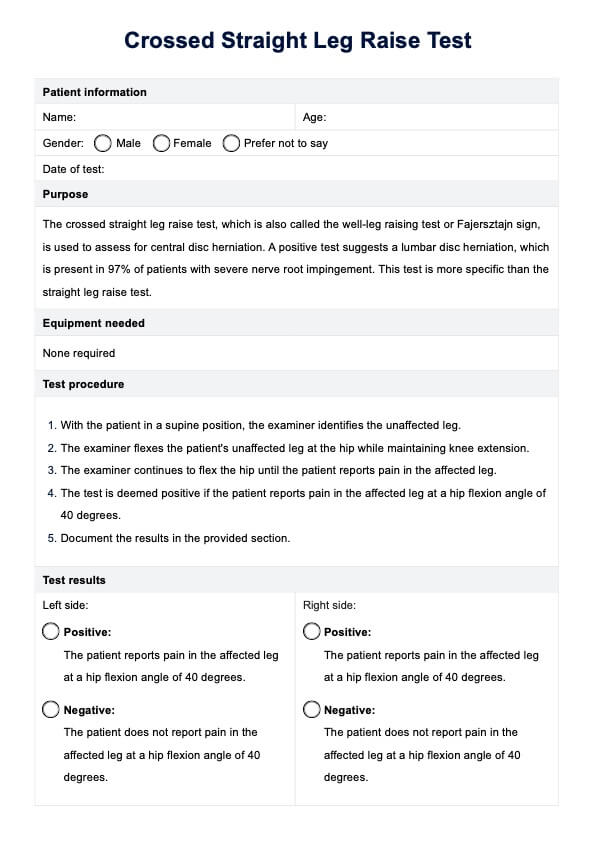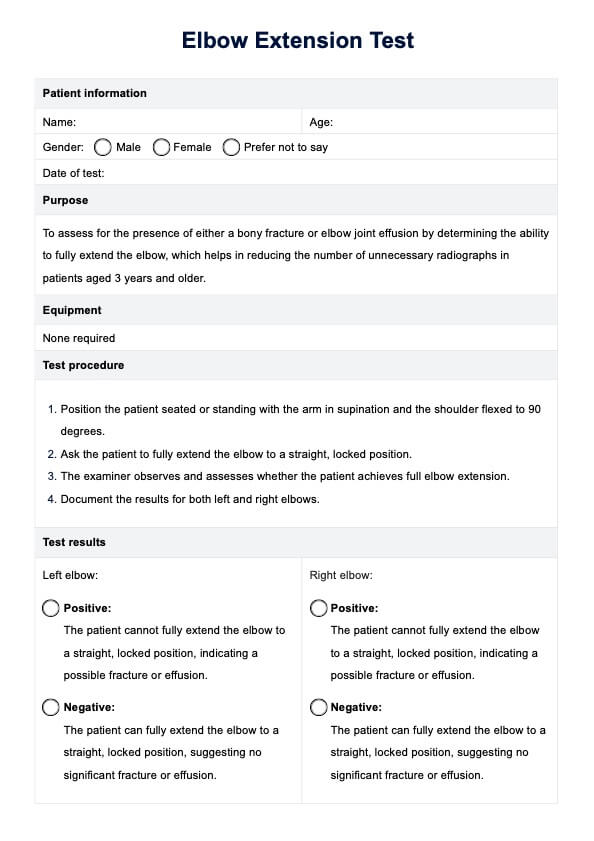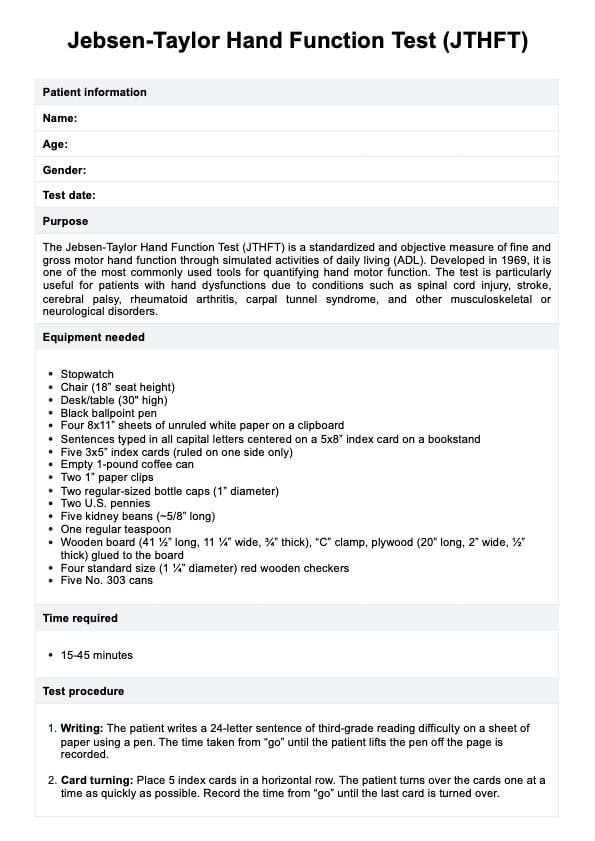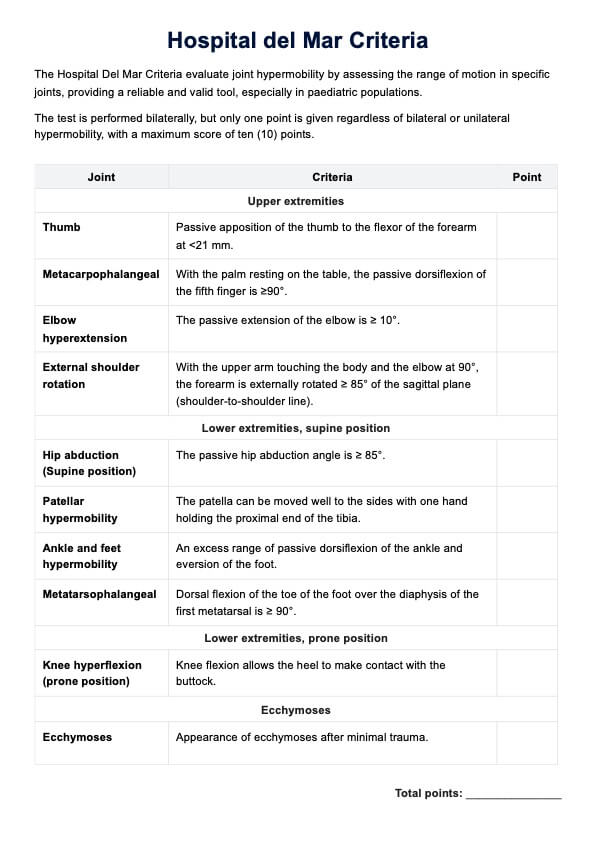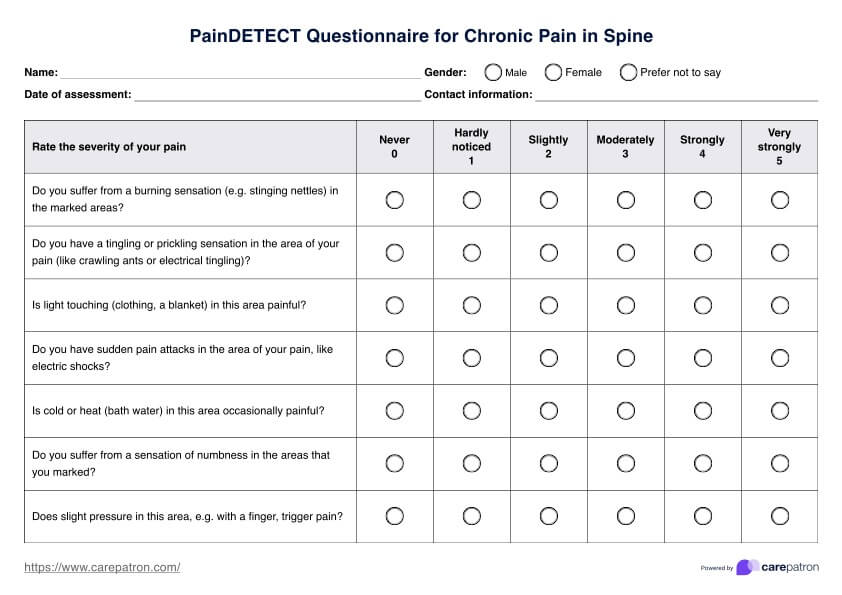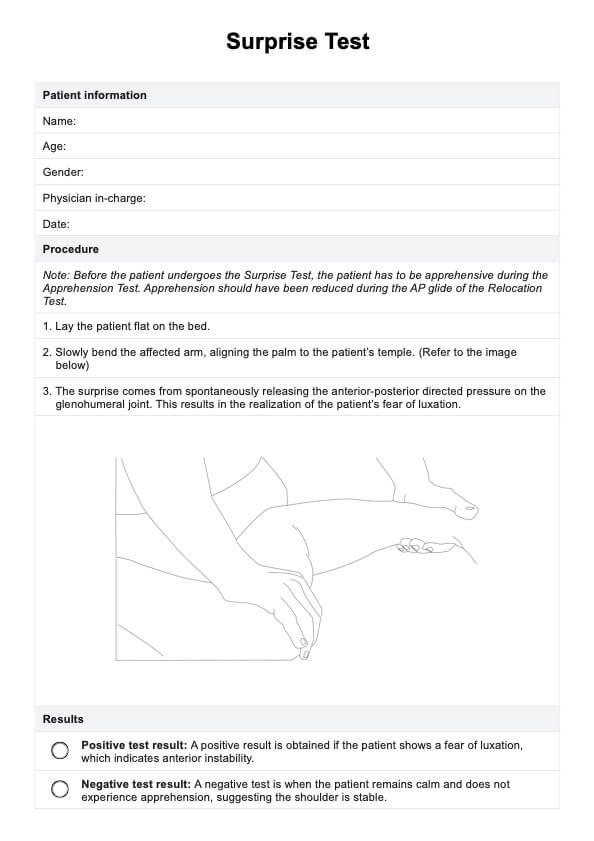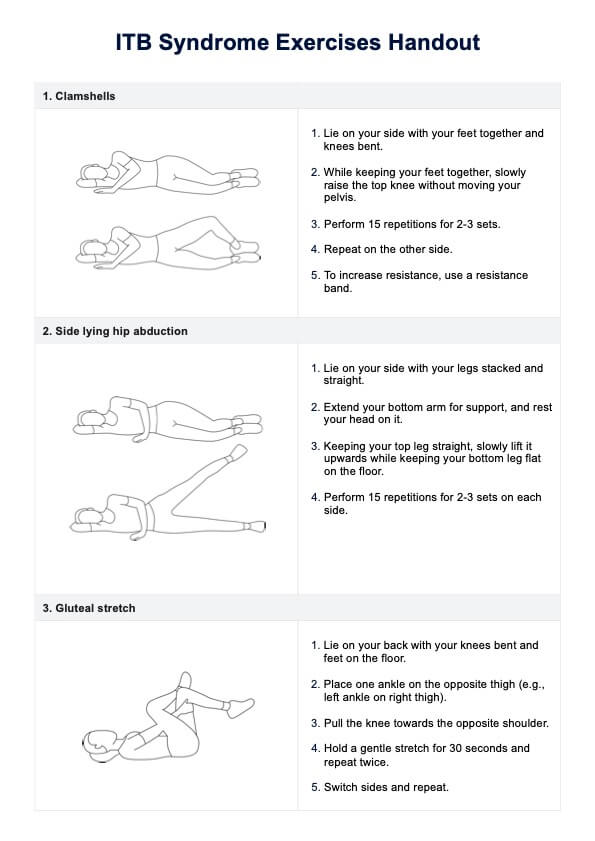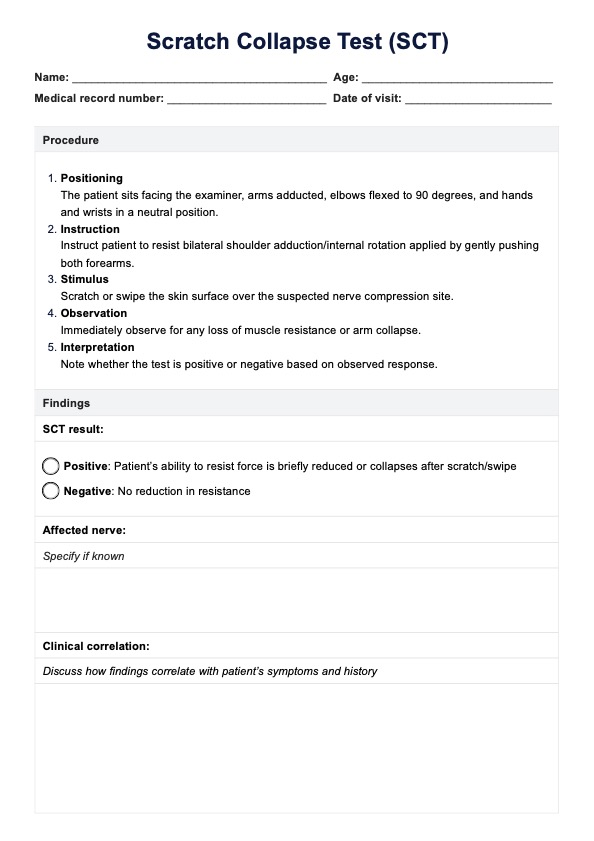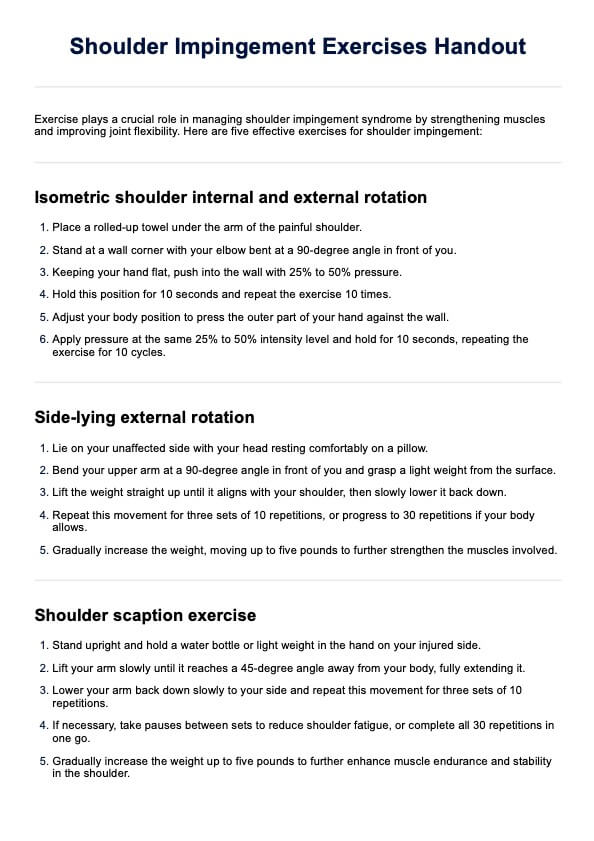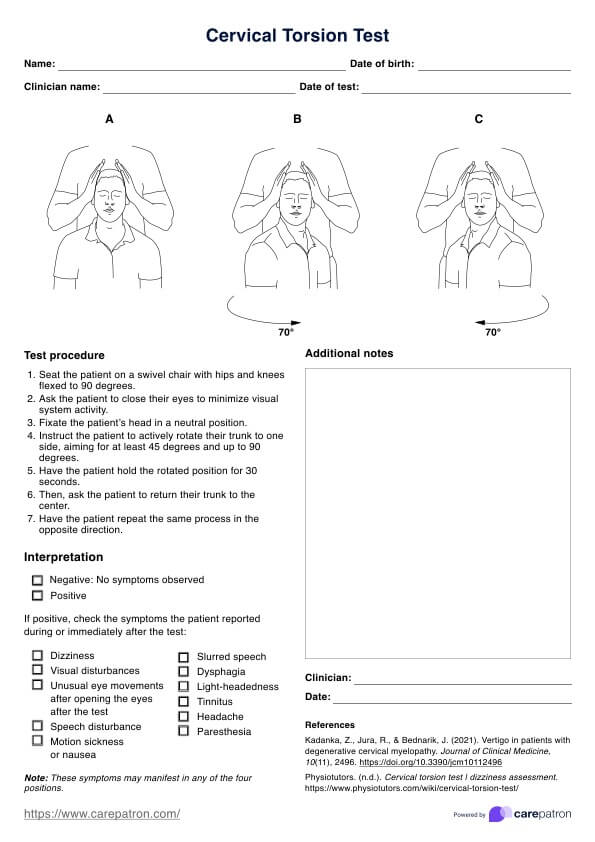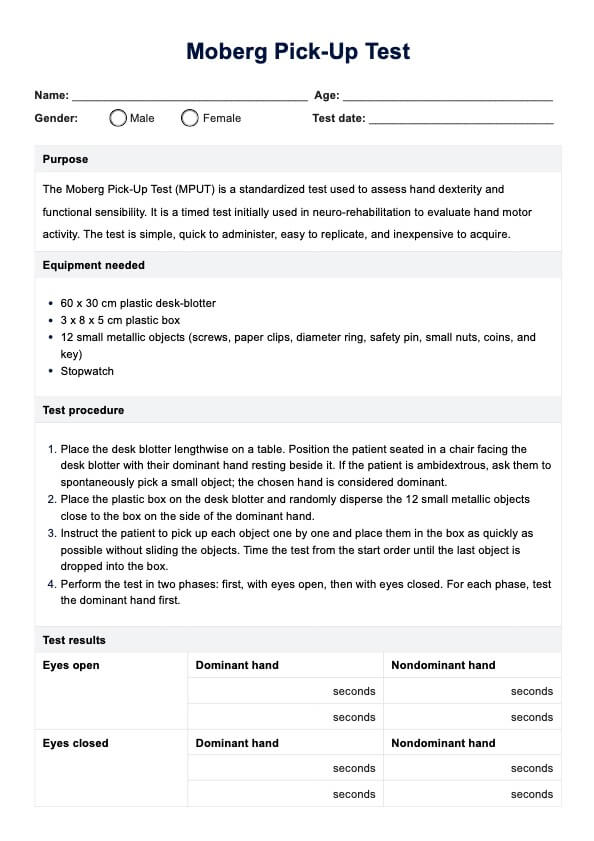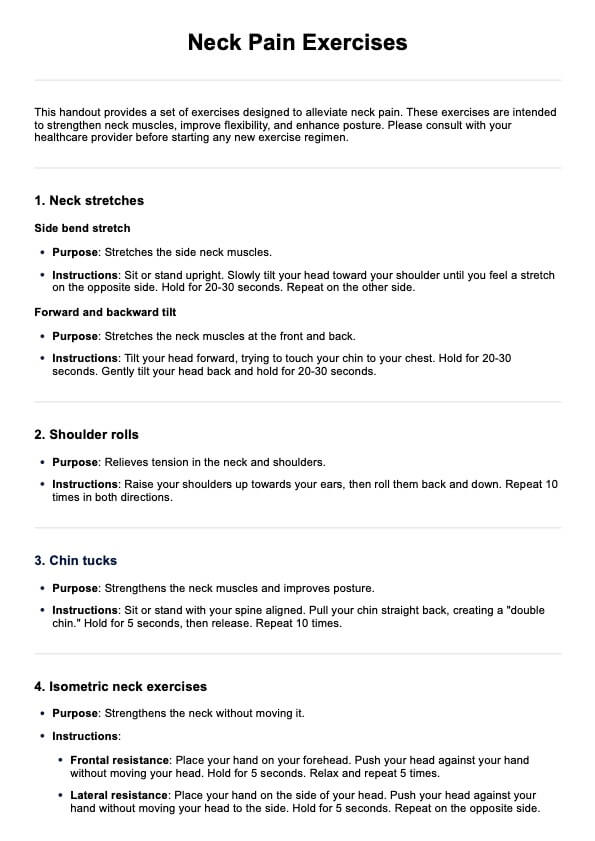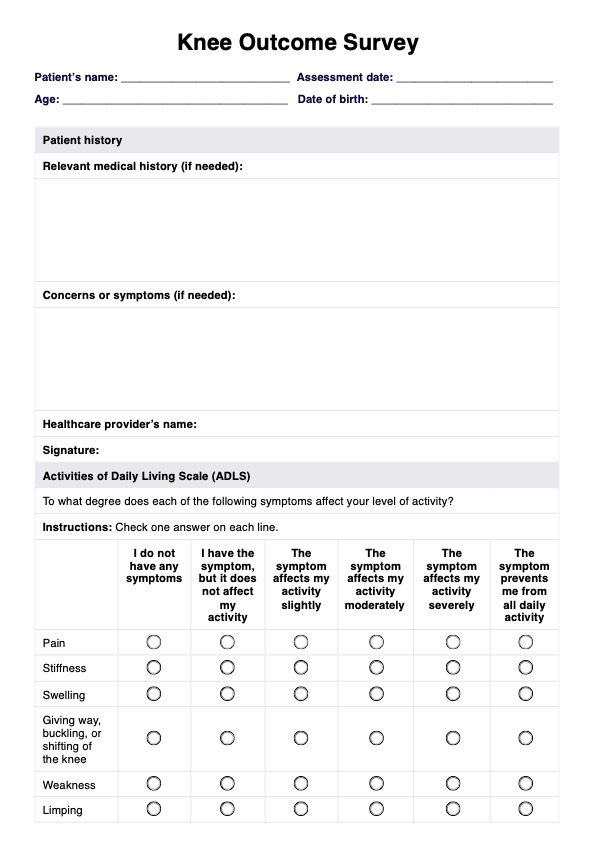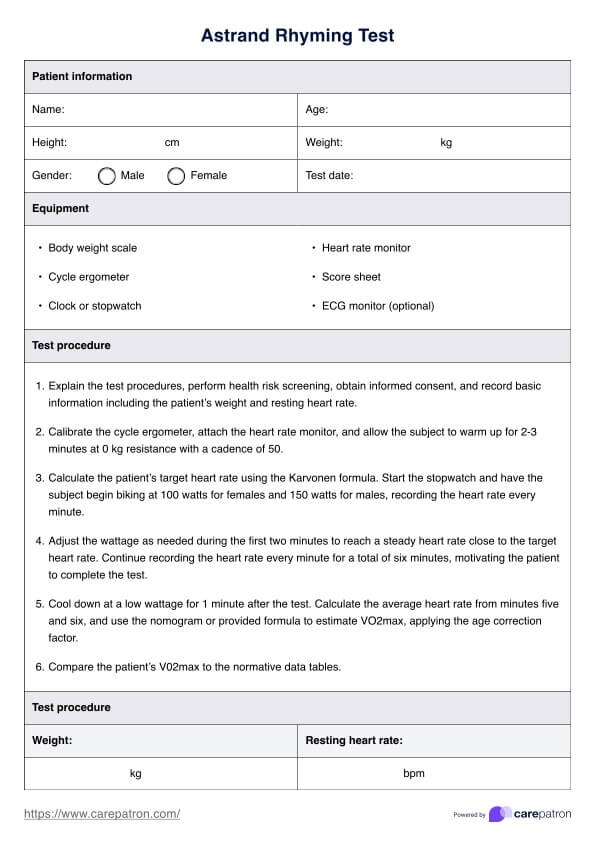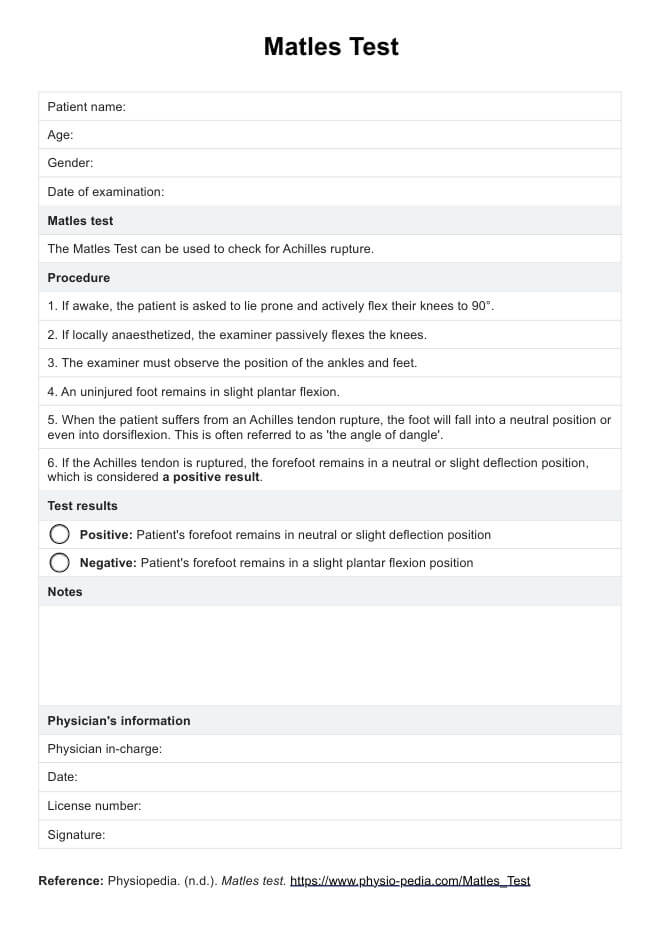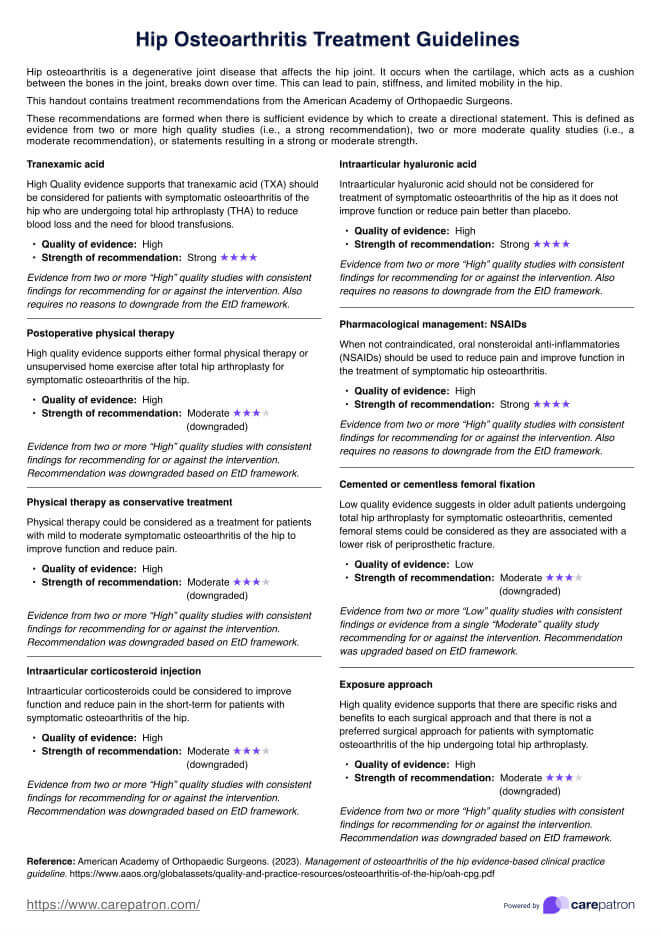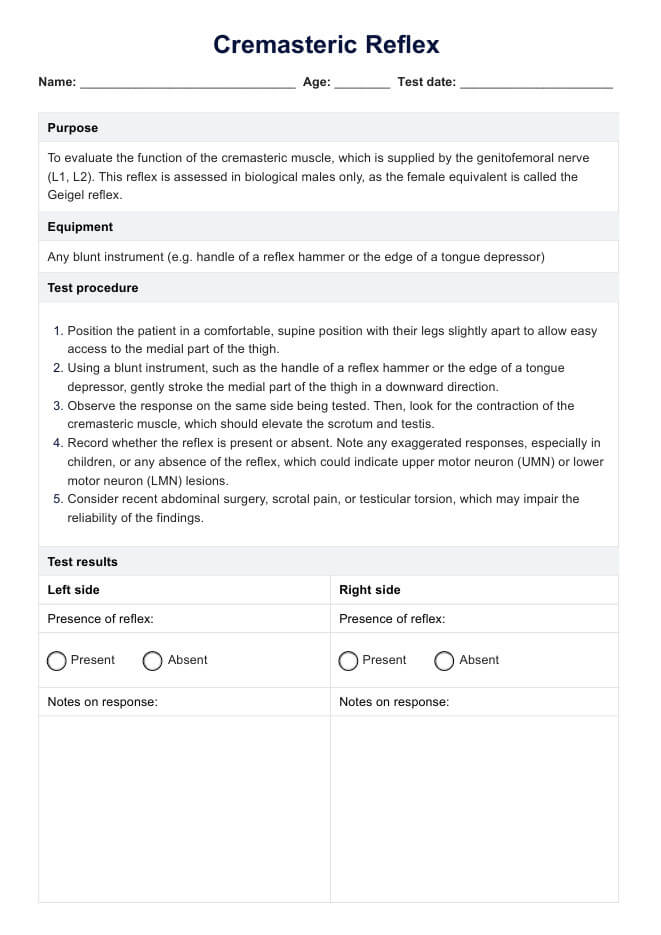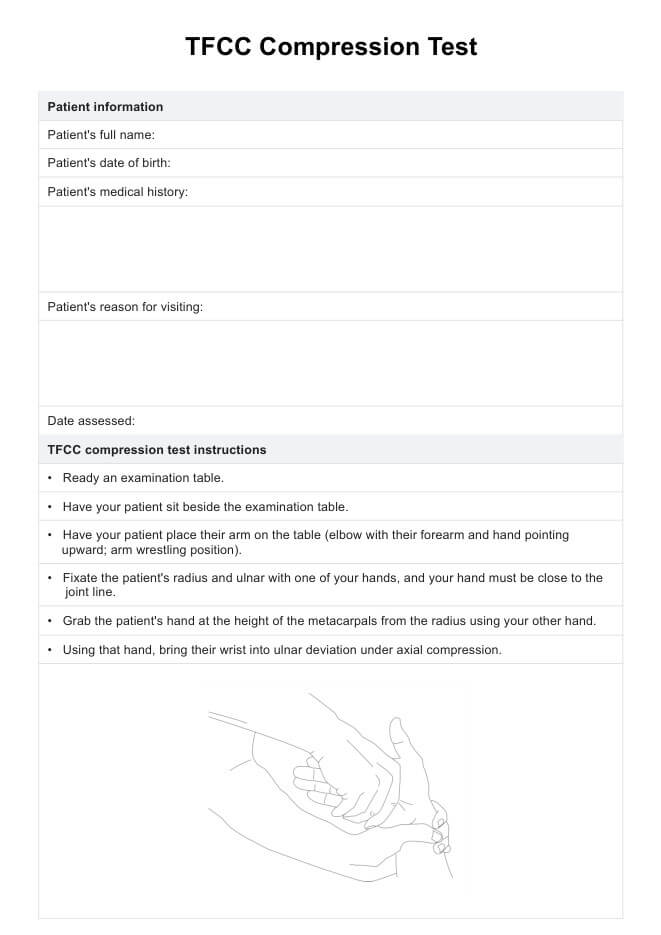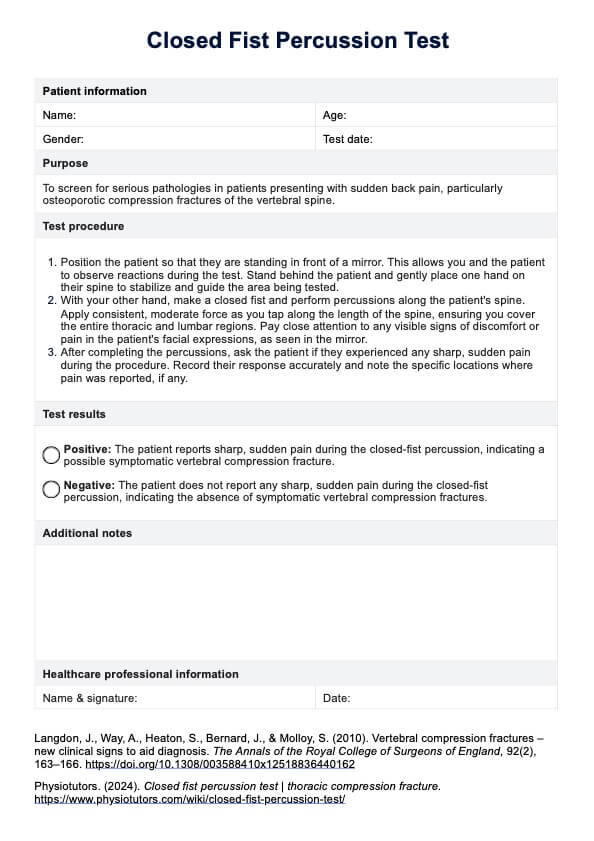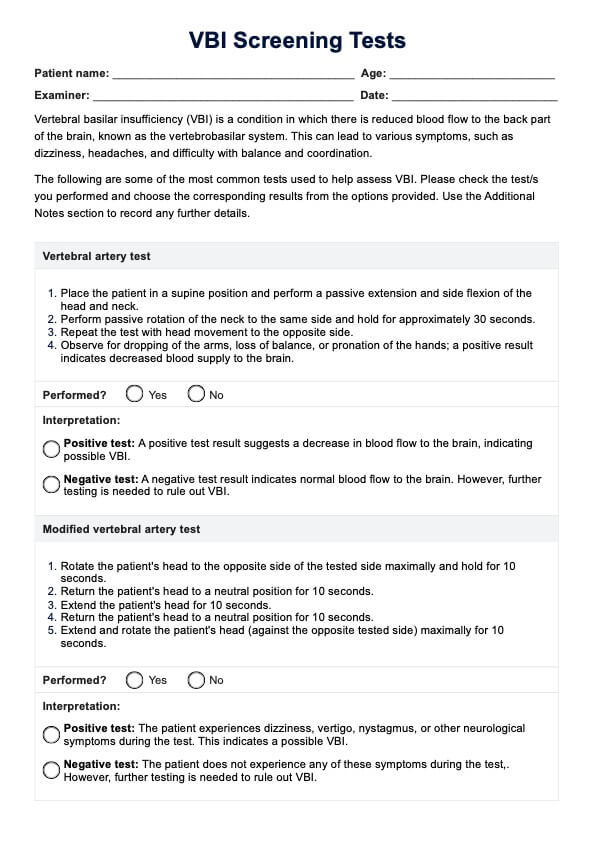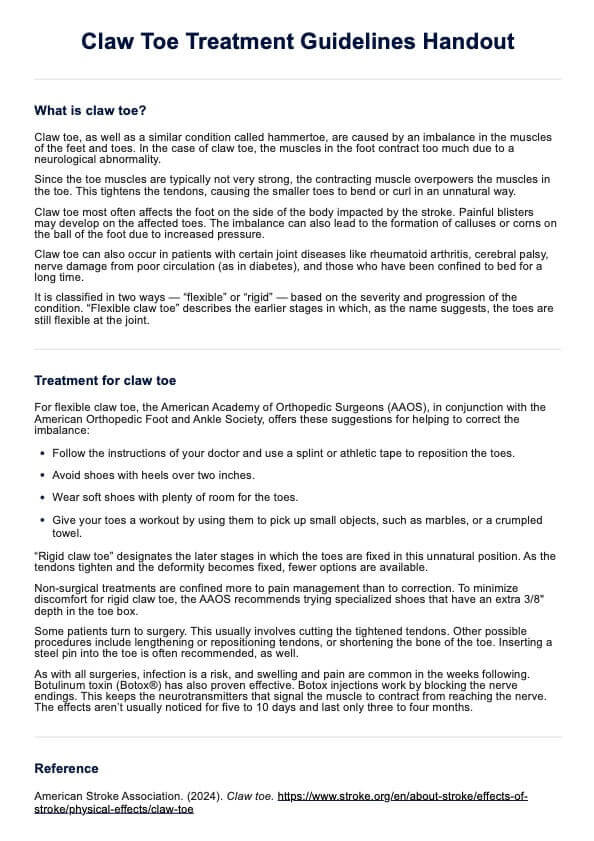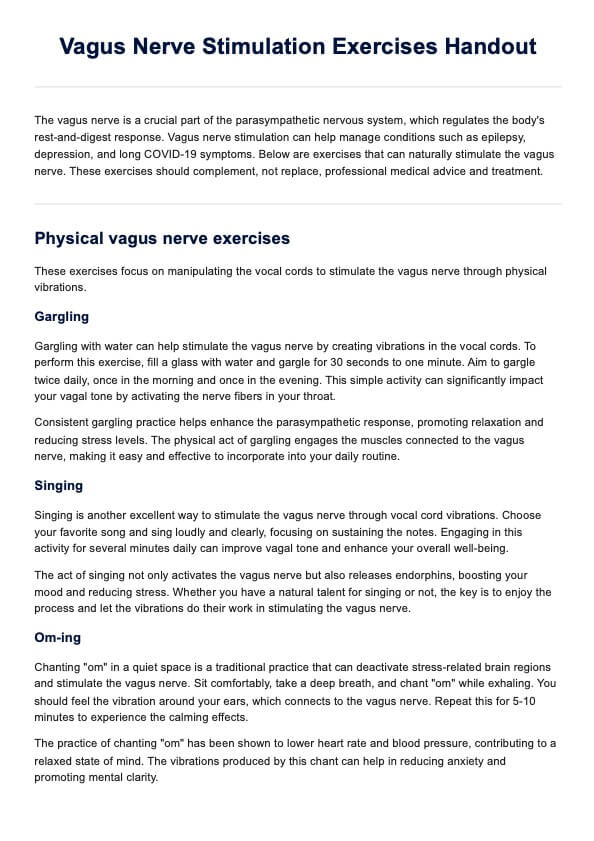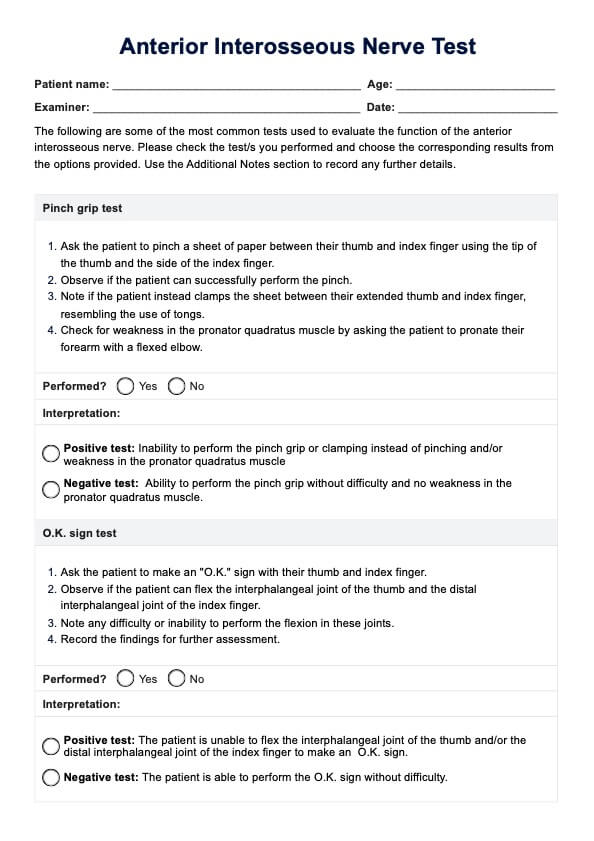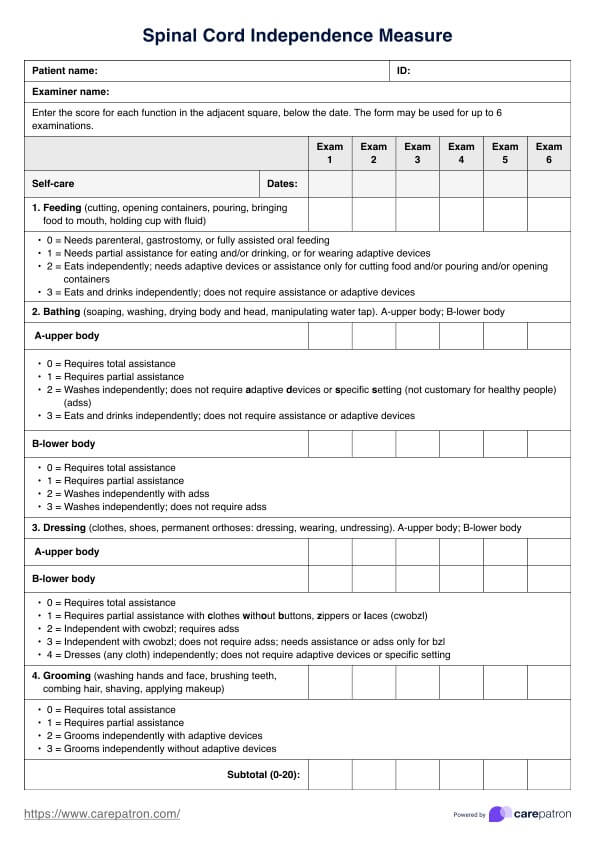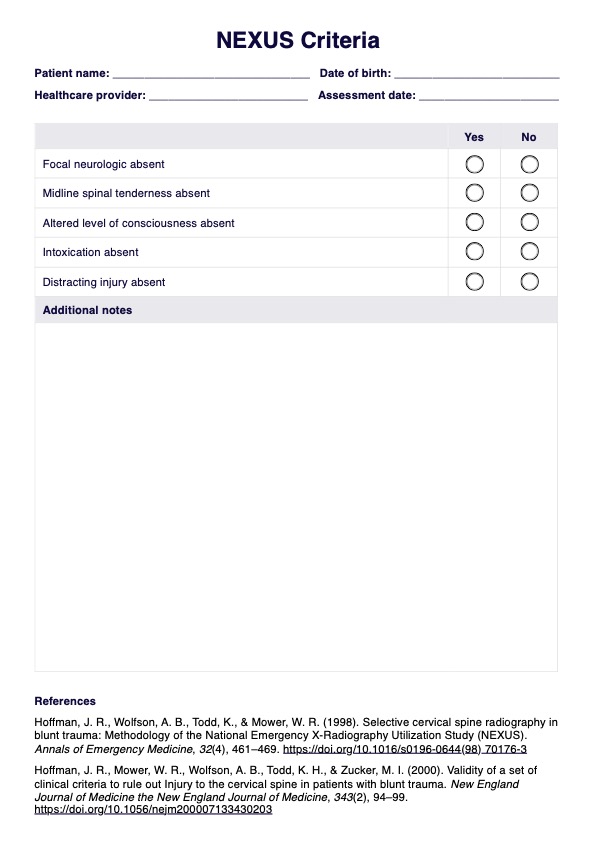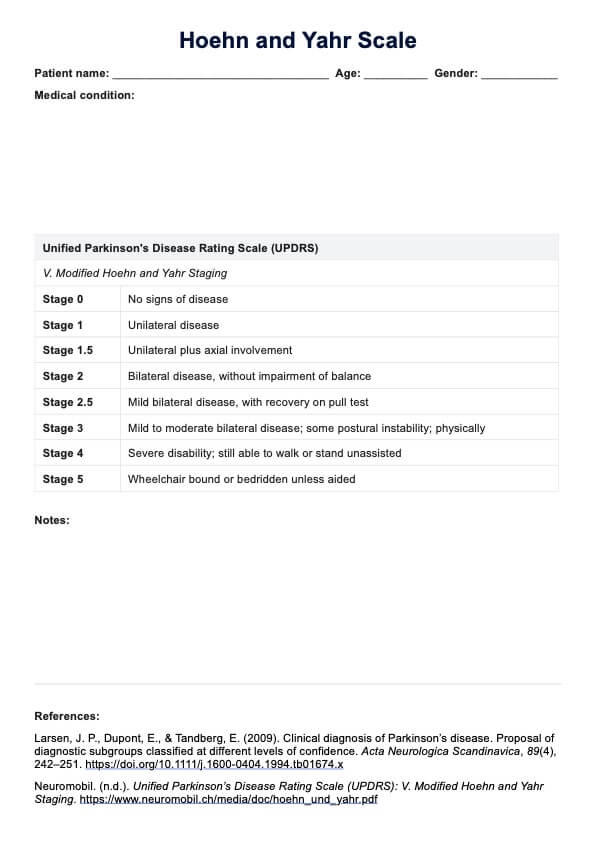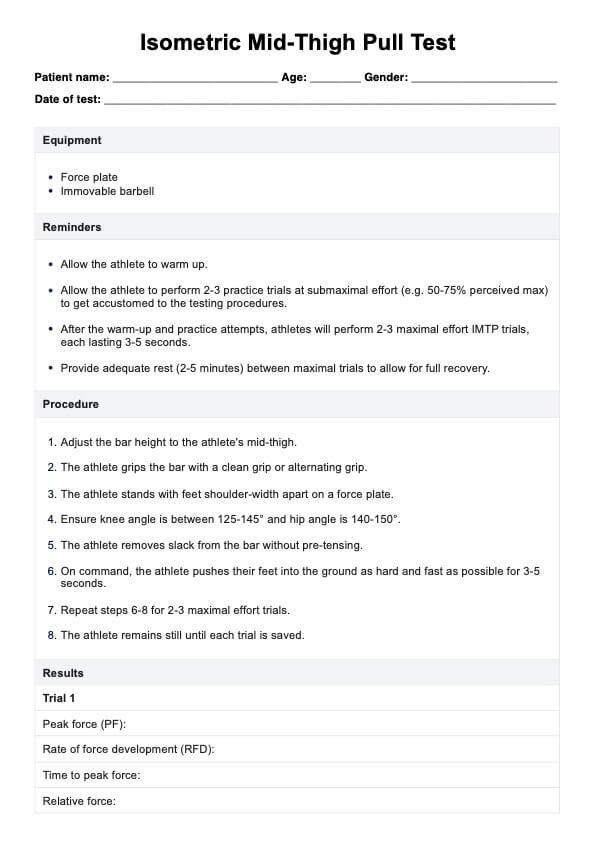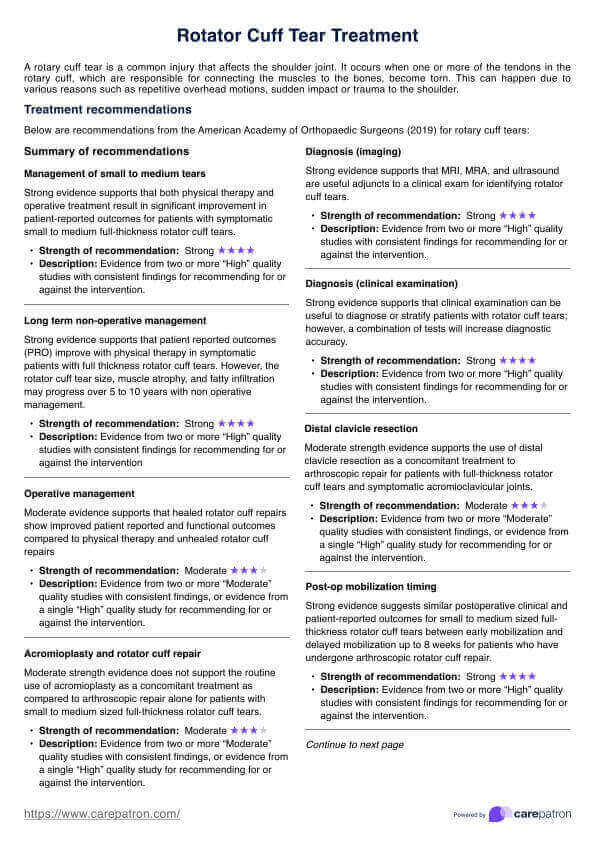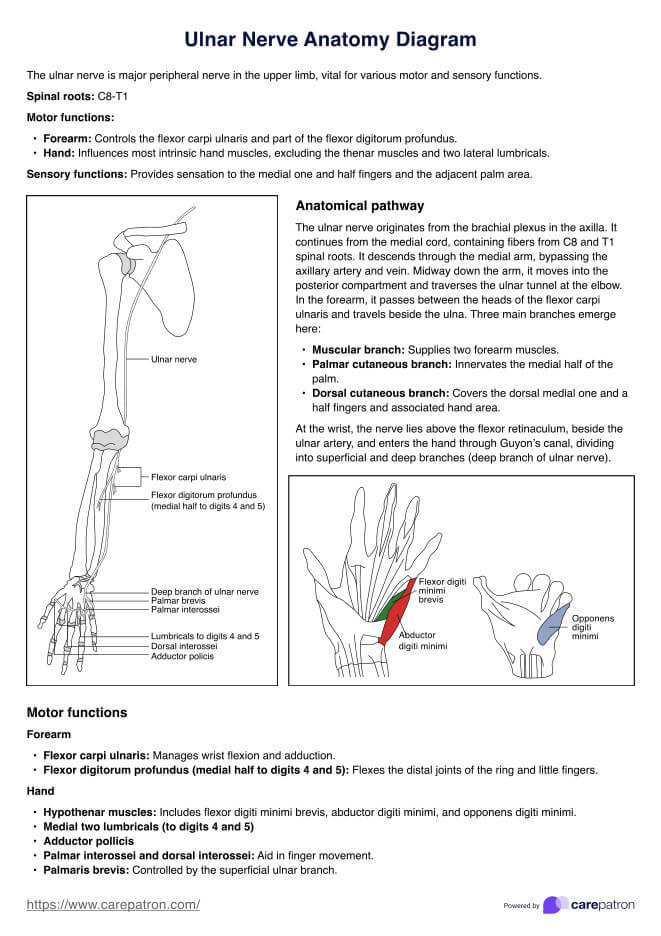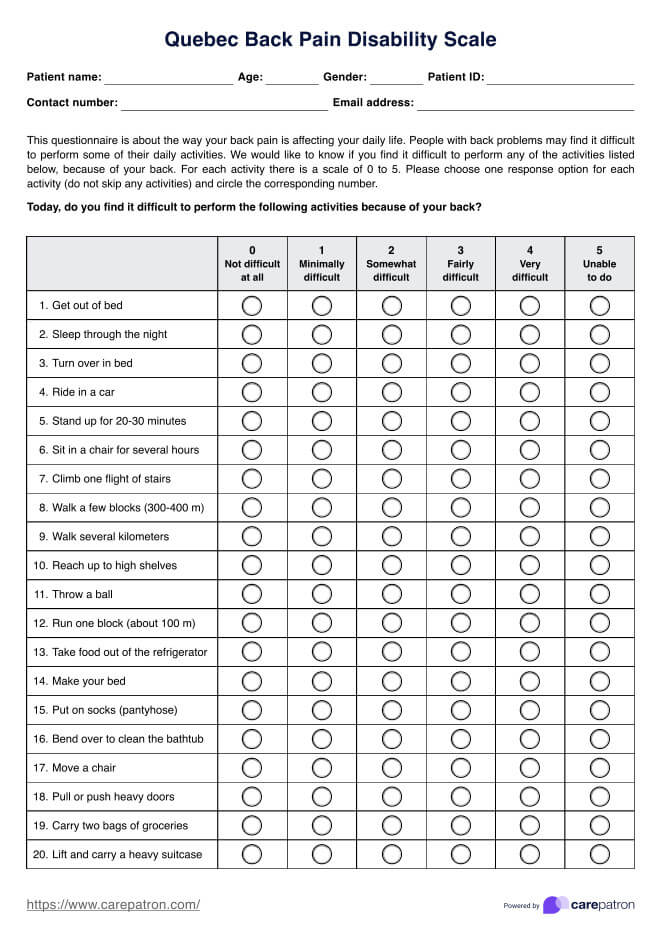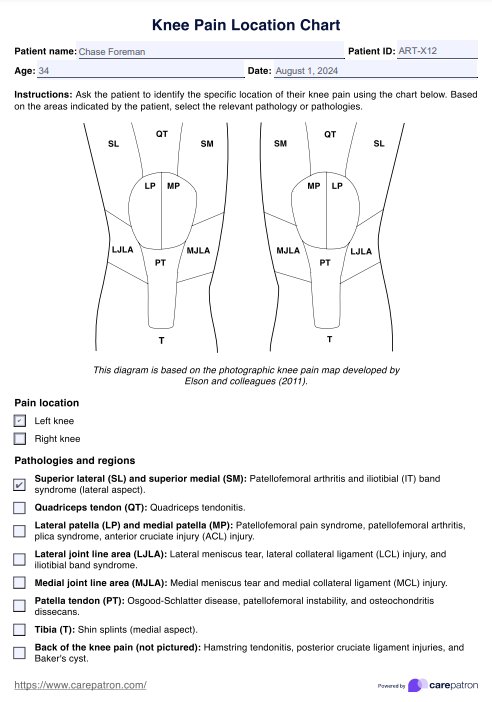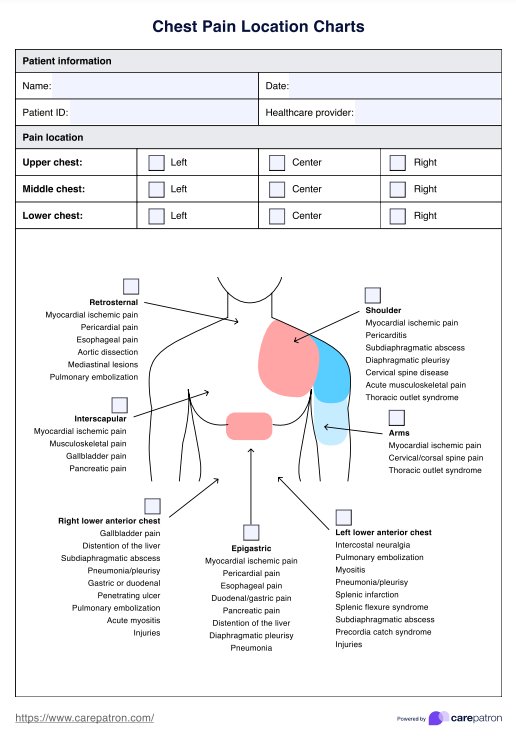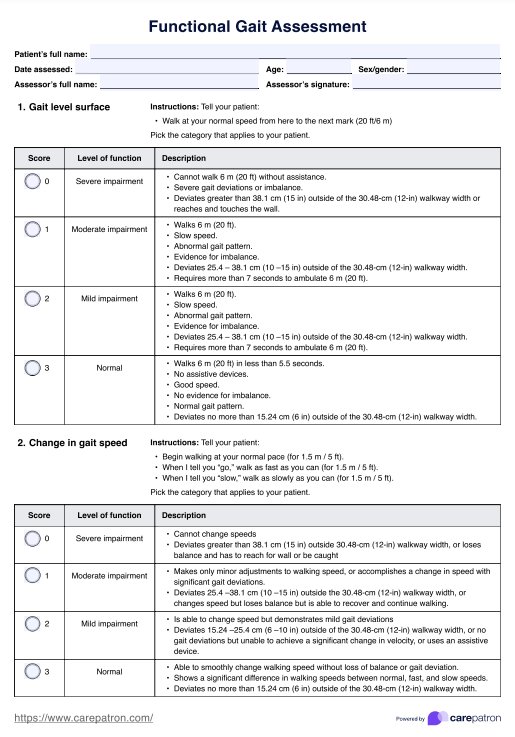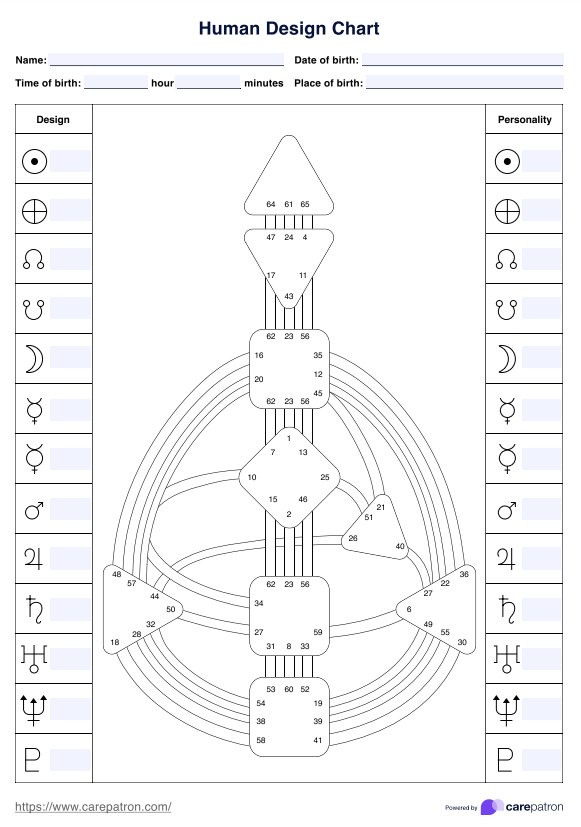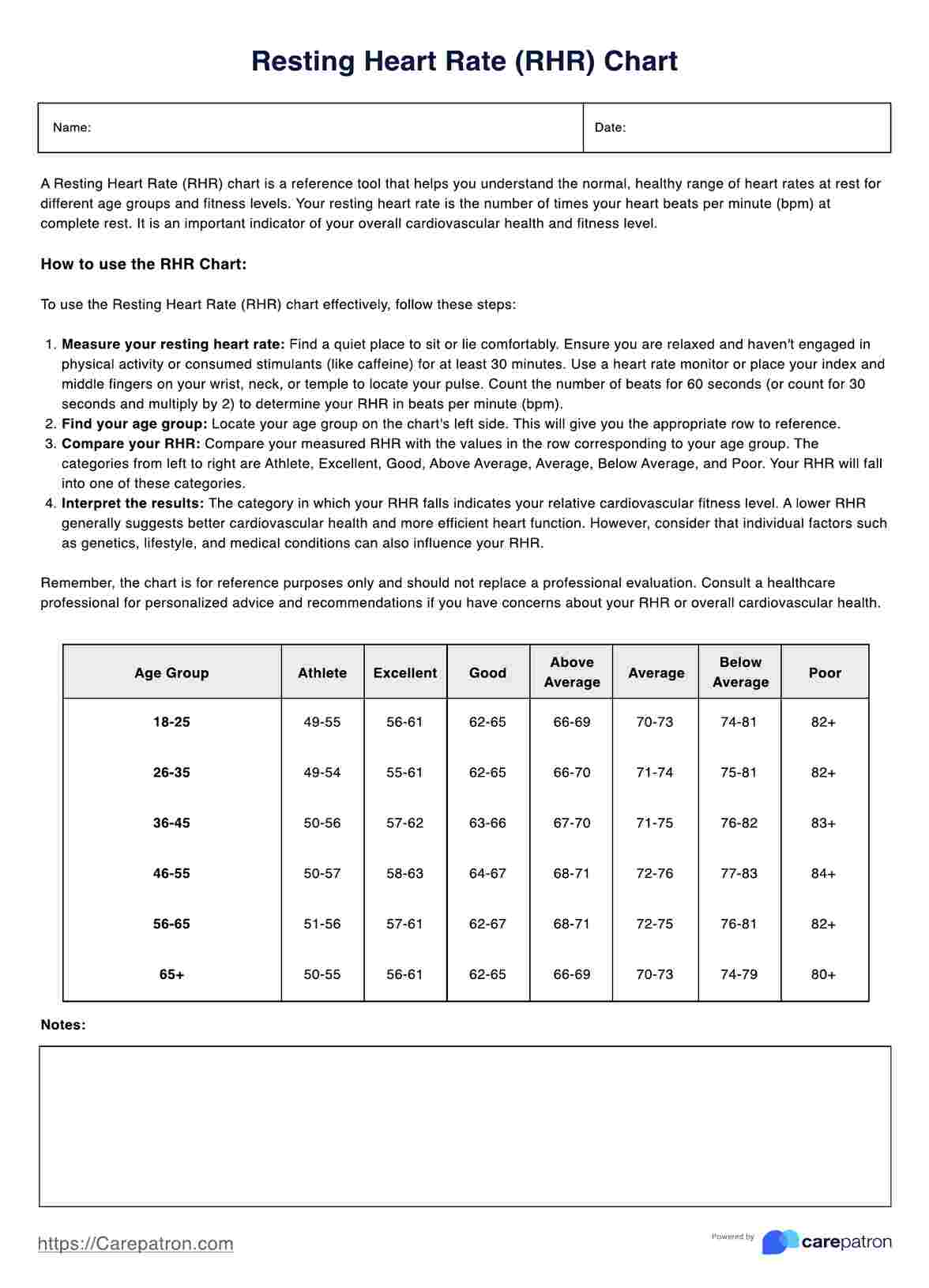Six Minute Walk Test
Use our Six-Minute Walk Test template to accurately assess your patient's fitness and exercise capacity with ATS- and ANPT-recommended guidelines and values.


What is a Six-Minute Walk Test?
The Six-Minute Walk Test (6MWT) is a standardized exercise test designed to measure the distance a person can walk in six minutes. This test evaluates functional capacity, exercise tolerance, and aerobic fitness, particularly in individuals with pulmonary and cardiovascular systems conditions. The test is widely used for patients with chronic respiratory disease, chronic lung disease patients, and neuromuscular disorders, and is effective in monitoring changes over time.
Pulmonologists, cardiologists, physiotherapists, and geriatric specialists commonly use the six-minute walking test. Its simplicity, non-invasiveness, and reliability make it ideal for assessing patients across different age groups, including children and older adults. It is also frequently used in research and physical education settings for assessing aerobic capacity and functional limitations.
The validity, reliability, and responsiveness of the 6MWT vary depending on the condition. For example, it demonstrates excellent test-retest reliability in conditions such as Alzheimer’s (Ries et al., 2009), osteoarthritis (Kennedy et al., 2005), stroke (Fulk & Echternach, 2008), traumatic brain injury/TBI (van Loo et al., 2004), Parkinson’s disease (Steffen & Seney, 2008), and spinal cord injury (Scivoletto et al., 2011).
Following guidelines set by the American Thoracic Society (2002), the 6MWT includes specific encouragement phrases and measures recovery periods, ensuring consistency in conducting the test and interpreting its outcomes.
Six Minute Walk Test Template
Six Minute Walk Test Example
How to use our Six-Minute Walk Test template?
Our Six-Minute Walk Test template provides healthcare professionals with a comprehensive framework for conducting the 6MWT. It includes a Borg scale, a list of necessary equipment, step-by-step instructions, and fields to record critical data, such as vital signs and the distance walked. Follow these steps to use our template effectively:
Step 1: Access the template
Click the “Use Template” button on the Carepatron webpage to open the template directly in the web app. From there, you can customize the template, fill it out digitally, print it, or share it online. Alternatively, you can click the “Download” button to save a non-customizable but digitally fillable and printable PDF version to your device.
Step 2: Prepare the patient and gather information
Record the patient's information, including their name, age, and any usual medications (which may affect blood pressure and heart rate) on the template. Confirm they are wearing comfortable clothing and shoes, and note any usual walking aids they might use, such as a cane or walker. Take and document baseline vitals, including heart rate and oxygen saturation (optional). Ask the patient to rate their dyspnea and fatigue using the Borg scale before beginning the test.
Step 3: Conduct the test
Position the patient at the starting line of the 30-meter hallway and explain the procedure using the template’s standardized instructions. Start the test and monitor the patient for any symptoms, such as chest pain or breathlessness. Use the provided template as a reference for specific phrases to use for instructions and encouragement and to document laps completed, the time elapsed, and other details.
Step 4: Record post-test data
After the test, use the template to document the total distance walked, calculated from the number of laps and additional meters covered. Record the patient’s post-test vitals, including blood pressure, heart rate, oxygen saturation, and Borg scale ratings for dyspnea and fatigue.
Step 5: Discuss results with the patient
Interpret the test findings using the normative values and condition-specific data provided in the template. You can either use the table with normative reference ranges compiled by Steffen et al. (2002) or use the formulae in the template as developed by Enright & Sherrill (2002):
- Male: distance = (7.57 × height cm) - (5.02 × age) - (1.76 × weight kg) - 309
- Female: distance = (2.11 × height cm) - (2.29 × weight kg) - (5.78 × age) + 667
Explain the significance of their performance, such as whether their distance falls within the typical range for their age and gender, and provide recommendations based on their results. Teach the patient how this information can guide their fitness and health improvement goals.
Benefits of doing the Six-Minute Walk Test
Our Six-Minute Walk Test template offers several advantages for healthcare professionals aiming to streamline patient assessments. With its structured design and comprehensive data fields, this tool enhances both the accuracy of testing and patient care. Here’s why it’s valuable:
- Requires minimal equipment: The test only needs a stopwatch, cones, a 30-meter hallway, and optional tools like a pulse oximeter. The simplicity of the setup makes it an accessible and cost-effective assessment.
- Improves monitoring and progress tracking: The template facilitates consistent data collection, allowing professionals to track patient improvements, whether in functional mobility, endurance, or response to treatment interventions.
- Aids in screening for heart disease and other conditions: With data fields for vital signs and post-test observations, the template supports early detection of cardiovascular and pulmonary issues, helping guide further diagnostic and treatment plans.
- Promotes standardization and reliability: By incorporating evidence-based protocols, the template ensures that every test is conducted and documented according to established guidelines, improving test accuracy and consistency across practitioners.
Apart from those, you get all the benefits of a free Carepatron account if you sign up—including streamlined practice management, no-sweat billing, access to hundreds of free templates, and HIPAA-compliant security.
References
Academy of Neurologic Physical Therapy. (n.d.). 6 minute walk test. https://www.neuropt.org/docs/default-source/cpgs/core-outcome-measures/6mwt-pocket-guide-proof9.pdf?sfvrsn=9ee25043_0
ATS Committee on Proficiency Standards for Clinical Pulmonary Function Laboratories. (2002). ATS statement: Guidelines for the six-minute walk test. American Journal of Respiratory and Critical Care Medicine, 166(1), 111–117. National Library of Medicine. https://doi.org/10.1164/ajrccm.166.1.at1102
Fulk, G. D., & Echternach, J. L. (2008). Test-Retest reliability and minimal detectable change of gait speed in individuals undergoing rehabilitation after stroke. Journal of Neurologic Physical Therapy, 32(1), 8–13. https://doi.org/10.1097/npt0b013e31816593c0
Kennedy, D. M., Stratford, P. W., Wessel, J., Gollish, J. D., & Penney, D. (2005). Assessing stability and change of four performance measures: A longitudinal study evaluating outcome following total hip and knee arthroplasty. BMC Musculoskeletal Disorders, 6(1). https://doi.org/10.1186/1471-2474-6-3
Ries, J. D., Echternach, J. L., Nof, L., & Gagnon Blodgett, M. (2009). Test-retest reliability and minimal detectable change scores for the timed “up & go” test, the six-minute walk test, and gait speed in people with Alzheimer's. Physical Therapy, 89(6), 569–579. https://doi.org/10.2522/ptj.20080258
Scivoletto, G., Tamburella, F., Laurenza, L., Foti, C., Ditunno, J. F., & Molinari, M. (2011). Validity and reliability of the 10-m walk test and the 6-min walk test in spinal cord injury patients. Spinal Cord, 49(6), 736–740. https://doi.org/10.1038/sc.2010.180
Steffen, T. M., Hacker, T. A., & Mollinger, L. (2002). Age- and gender-related test performance in community-dwelling elderly people: Six-minute walk test, Berg Balance Scale, timed up & Go test, and gait speeds. Physical Therapy, 82(2), 128–137. https://doi.org/10.1093/ptj/82.2.128
Steffen, T., & Seney, M. (2008). Test-Retest reliability and minimal detectable change on balance and ambulation tests, the 36-item Short-Form Health Survey, and the Unified Parkinson Disease Rating Scale in people with Parkinsonism. Physical Therapy, 88(6), 733–746. https://doi.org/10.2522/ptj.20070214
van Loo, M. A., Moseley, A. M., Bosman, J. M., de Bie, R. A., & Hassett, L. (2004). Test–re-test reliability of walking speed, step length and step width measurement after traumatic brain injury: A pilot study. Brain Injury, 18(10), 1041–1048. https://doi.org/10.1080/02699050410001672314
Commonly asked questions
A normal result for healthy adults ranges from 400 to 700 meters, depending on factors like age, gender, and fitness level. Our template includes a detailed table with normative values for older adults, allowing healthcare professionals to interpret results more accurately.
The test requires a 30-meter corridor, a stopwatch, cones for turnaround points, and optional tools like a pulse oximeter. Participants walk for six minutes while being encouraged at regular intervals. This is a brief overview—our template and guide provide the full ATS-recommended protocol.
Yes, but assistance is limited to providing the patient's usual walking aids (e.g., canes, walkers) and supplemental oxygen if prescribed. Any further physical assistance could invalidate the results.


